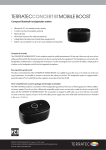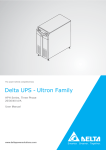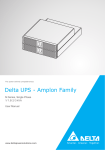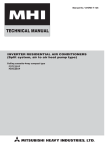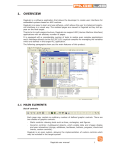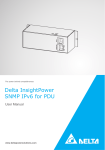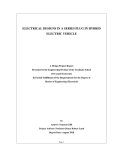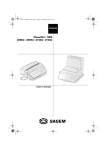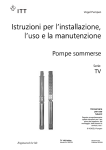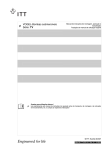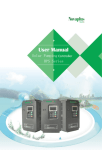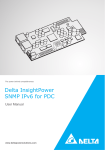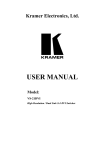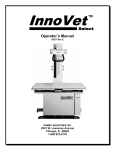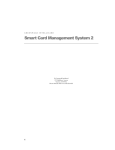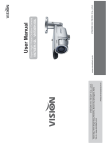Download HPH Series 60/80/100/120 kW (User Manual)
Transcript
EPO
NORM
AL
BATTE
RY
BYPAS
S
FAULT
ESC
ON
OFF
The power behind competitiveness
Delta UPS - Ultron Family
HPH Series, Three Phase
60/80/100/120 kVA
User Manual
www.deltapowersolutions.com
Save This Manual
This manual contains important instructions and warnings that you should follow
during the installation, operation, storage and maintenance of this product. Failure
to heed these instructions and warnings will void the warranty.
Copyright © 2015 by Delta Electronics Inc. All Rights Reserved. All rights of this User Manual
(“Manual”), including but not limited to the contents, information, and figures are solely owned and
reserved by Delta Electronics Inc. (“Delta”). The Manual can only be applied to the operation or the
XVHRIWKLVSURGXFW$Q\GLVSRVLWLRQGXSOLFDWLRQGLVVHPLQDWLRQUHSURGXFWLRQPRGL¿FDWLRQWUDQVODWLRQ
extraction, or usage of this Manual in whole or in part is prohibited without the prior written permission
of Delta. Given that Delta will continuously improve and develop the product, changes may be made
to the information in this Manual at any time without obligation to notify any person of such revision
or changes. Delta will make all possible efforts to secure the accuracy and the integrity of this
Manual. Delta disclaims any kinds or forms of warranty, guarantee, or undertaking, either expressly
or implicitly, including but not limited to the completeness, faultlessness, accuracy, non-infringement,
PHUFKDQWDELOLW\RU¿WQHVVIRUDSDUWLFXODUSXUSRVHRIWKH0DQXDO
Ultron HPH Series UPS
II
Table of Contents
Table of Contents
Chapter 1 : Important Safety Instructions ------------------------------------------1
1.1
Placement Warnings---------------------------------------------------------------- 1
1.2
Connection Warnings--------------------------------------------------------------- 1
1.3
Usage Warnings --------------------------------------------------------------------- 1
1.4
Storage Warnings ------------------------------------------------------------------- 2
1.5
Glossary of Symbols ---------------------------------------------------------------- 3
1.6
Standard Compliance -------------------------------------------------------------- 4
Chapter 2 : Introduction ------------------------------------------------------------------5
2.1
Product Introduction ---------------------------------------------------------------- 5
2.2
Package Inspection ----------------------------------------------------------------- 5
2.3
Functions and Features------------------------------------------------------------ 7
Chapter 3 : Appearance and Mechanism--------------------------------------------9
3.1
Appearance and Dimensions----------------------------------------------------- 9
3.2
Control Panel ------------------------------------------------------------------------10
3.3
Front/ Rear Panel ------------------------------------------------------------------12
Chapter 4 : Operation Modes --------------------------------------------------------- 17
Chapter 5 : Communication Interfaces -------------------------------------------- 21
Chapter 6 : Installation and Wiring -------------------------------------------------- 27
6.1
Precautions Prior to Installation and Wiring ---------------------------------27
6.2
Installation Environment ----------------------------------------------------------27
6.3
UPS Transportation & Handling ------------------------------------------------28
6.4
UPS Installation & Fixing ---------------------------------------------------------28
6.5
Wiring ----------------------------------------------------------------------------------31
6.6
6.5.1
Precautions Prior to Wiring ------------------------------------------31
6.5.2
Single Unit Wiring ------------------------------------------------------34
6.5.3
Parallel Units Wiring ---------------------------------------------------41
External Battery Cabinet Connection Precautions -------------------------44
Chapter 7 : UPS Operation ------------------------------------------------------------- 49
7.1
Single Unit Operation Procedures ---------------------------------------------49
7.1.1
Normal Mode Start-up Procedures (Single) ---------------------49
III
7.2
7.1.2
Battery Mode Start-up Procedures (Single) ---------------------49
7.1.3
Bypass Mode Start-up Procedures (Single) ---------------------50
7.1.4
Manual Bypass Mode Start-up Procedures (Single Unit) ----50
7.1.5
Normal Mode Turn-off Procedures (Single) ---------------------51
7.1.6
Battery Mode Turn-off Procedures (Single) ----------------------51
7.1.7
Bypass Mode Turn-off Procedures (Single) ---------------------52
7.1.8
Manual Bypass Mode Turn-off Procedures (Single) -----------52
Parallel Units Operation Procedures ------------------------------------------53
7.2.1
Normal Mode Start-up Procedures (Parallel) -------------------53
7.2.2
Battery Mode Start-up Procedures (Parallel)--------------------53
7.2.3
Bypass Mode Start-up Procedures (Parallel) -------------------53
7.2.4
Manual Bypass Mode Start-up Procedures (Parallel)---------54
7.2.5
Normal Mode Turn-off Procedures (Parallel) --------------------55
7.2.6
Battery Mode Turn-off Procedures (Parallel) --------------------55
7.2.7
Bypass Mode Turn-off Procedures (Parallel) --------------------56
7.2.8
Manual Bypass Mode Turn-off Procedures (Parallel) ---------56
Chapter 8 : LCD Display and Settings --------------------------------------------- 57
8.1
LCD Display Hierarchy ------------------------------------------------------------57
8.2
Main Screen -------------------------------------------------------------------------58
8.3
Parallel Screen ----------------------------------------------------------------------59
8.4
Main Menu ---------------------------------------------------------------------------60
8.5
Measure ------------------------------------------------------------------------------61
8.6
Maintenance -------------------------------------------------------------------------62
Chapter 9 : Optional Accessories --------------------------------------------------- 65
Chapter 10 : Maintenance -------------------------------------------------------------- 66
Chapter 11 : Troubleshooting --------------------------------------------------------- 67
$SSHQGL[7HFKQLFDO6SHFL¿FDWLRQV --------------------------------------------- 69
Appendix 2 : Warranty ------------------------------------------------------------------- 71
Ultron HPH Series UPS
IV
Chapter 1
Important Safety Instructions
Chapter 1 : Important Safety Instructions
1.1
Placement Warnings
yInstall the UPS in a well-ventilated indoor area, away from excess moisture, heat, dust,
ÀDPPDEOHJDVRUH[SORVLYHV
yLeave adequate space around all sides of the UPS for proper ventilation. Please refer to
6.2 Installation Environment.
1.2
Connection Warnings
yThe UPS must be well grounded due to a possible risk of current leakage.
yIt is necessary to install protective devices when the UPS is connected to the mains and
bypass source. For relevant information, please refer to 6.5.1 Precautions Prior to
Wiring.
yThe protective devices connecting to the UPS must be installed near the UPS and must
be easily accessible for operation.
1.3
Usage Warnings
yThis is a class-A product. In a domestic environment, this product may cause radio interference, in which case, the user is required to take adequate measures.
yThe UPS can be used to power computers and associated peripheral devices, such as
monitors, modems, cartridge tape drives, external hard drives, etc.
yIf the UPS needs to be connected to a motor load, it must be confirmed by qualified
service personnel.
yIt is strictly forbidden to connect the UPS with any regenerative-type loads.
yThe parallel UPSs can connect with common batteries.
yThe external slits and openings in the UPS are provided for ventilation. To ensure reliable
operation of the UPS and to protect the UPS from overheating, these slits and openings
must not be blocked or covered. Do not insert any object into the slits and openings that
may hinder ventilation.
yIn a low temperature environment (below 0°C), you must allow the UPS to adjust to room
temperature for at least one hour to avoid moisture condensing inside the UPS before
usage.
1
yDo not put beverage containers on the UPS, battery cabinet or any other accessory associated with the UPS.
yThe risk of dangerous high voltage is possible when the batteries are still connected to
the UPS even though the UPS is disconnected from the mains. Do not forget to pull out
the battery cable to completely cut off the battery source.
yDo not open or mutilate the battery or batteries. The released electrolyte is harmful to the
skin and eyes and may be toxic.
y'RQRWGLVSRVHRIWKHEDWWHU\RUEDWWHULHVLQD¿UH7KHEDWWHULHVPD\H[SORGH
y$OOPDLQWHQDQFHVHUYLFHVPXVWEHSHUIRUPHGE\TXDOL¿HGVHUYLFHSHUVRQQHO)RUELGRSHQing or removing the cover of the UPS to avoid high voltage electric shock.
y<RXPXVWFRQWDFWTXDOL¿HGVHUYLFHSHUVRQQHOLIHLWKHURIWKHIROORZLQJHYHQWVRFFXU
1. Liquid is poured or splashed on the UPS.
2. The UPS does not run normally after this User Manual is carefully observed.
NOTE:
If you use the UPS in an area that generates or incurs dust, you should install a dust
¿OWHULQWKH836WRHQVXUHQRUPDOSURGXFWOLIHDQGIXQFWLRQ
1.4
Storage Warnings
yPrior to Installation
If the UPS needs to be stored prior to installation, it should be placed in a dry area. The
allowable storage temperature is between -15°C and +50°C.
yAfter Usage
Press the OFF key (
) once and the LCD shows the following screen. If you want to
). Make sure the UPS is shutdown,
turn off the UPS, please press the DOWN key (
disconnect the UPS from the utility power, remove all equipment from the UPS, and store
the UPS in a dry and well-ventilated area at a temperature between -15°C and +50°C.
Idle batteries must be re-charged fully approximately every three months if the UPS
needs to be stored for an extended period of time. The charging time must not be less
than 24 hours each time.
6+87'2:1
?
<(6 12
Ultron HPH Series UPS
2
Chapter 1
1.5
Important Safety Instructions
Glossary of Symbols
No.
Symbol
Description
1
2QOLQHPRGH/('LQGLFDWRUJUHHQ
2
%DWWHU\PRGH/('LQGLFDWRU\HOORZ
3
%\SDVVPRGH/('LQGLFDWRU\HOORZ
4
)DXOW/('LQGLFDWRUUHG
5
ON key
6
OFF key
7
Goes back to previous screen or cancels current selection.
8
Moves down/ Decreases number.
9
Moves up/ Increases number.
10
&RQ¿UPVVHOHFWLRQ
11
EPO key
12
R
R phase of AC Input/ Bypass Input/ UPS Output
13
S
S phase of AC Input/ Bypass Input/ UPS Output
14
T
T phase of AC Input/ Bypass Input/ UPS Output
15
N
Neutral line of AC Input/ Bypass Input/ UPS Output/ Battery
Input
16
For UPS grounding
17
For critical loads' grounding/ For external battery cabinet's
grounding
18
Positive battery terminal
19
Negative battery terminal
3
1.6
Standard Compliance
This product meets the following safety standards and electromagnetic compatibility (EMC)
LQVSHFWLRQVWDQGDUGV
yCE
yIEC62040-1
yGB7260.2-2009/ IEC62040-2 C3
yGB17626-2/ IEC61000-4-2 (ESD) Level 4
yGB17626-3/ IEC61000-4-3 (Radiated Field) Level 3
yGB17626-4/ IEC61000-4-4 (EFT) Level 4
yGB17626-5/ IEC61000-4-5 (Surge) Level 4
Ultron HPH Series UPS
4
Chapter 2
Introduction
Chapter 2 : Introduction
2.1
Product Introduction
The HPH series UPS is a three-phase four-wire online uninterruptible power supply which
provides reliable and stable sine-wave power to your electronic devices. The UPS applies the
latest design of DSP digital control technology and highest quality assembly, with an output
SRZHUIDFWRUXSWRXQLW\7KHHI¿FLHQF\RIWKHHQWLUHGHYLFHFDQUHDFKXSWRLQRQOLQH
PRGHDQGXSWRLQ(&2PRGH:LWKLWVRXWVWDQGLQJIHDWXUHVWKH836QRWRQO\SURYLGHV
safe, reliable and uninter-rupted power to your sensitive electronic equipment at all times, but
DOVRSURGXFHVJUHDWHUHOHFWULFSRZHUHI¿FLHQF\DWOHVVFRVW7KLV+3+VHULHV836SURYLGHV
four different rated power levels, 60kVA, 80kVA, 100kVA and 120kVA, for your selection.
2.2
Package Inspection
yExternal
During UPS transportation, some unpredictable situations might occur. It is recommended
that you inspect the UPS exterior packaging. If you notice any damage, please
immediately contact the dealer from whom you purchased the unit.
yInternal
1. Check the rating label on the top of the UPS cabinet and make sure the device No.
and capacity match what you ordered.
2. Examine if any parts are loose or damaged.
5
3. The UPS package contains the following items. Please check if any items are missing.
1
EPO
NORMAL
BATTERY
ON
OFF
BYPASS
FAULT
2
ESC
EPO
3
4
NORMAL
BATTERY
ON
OFF
BYPASS
FAULT
ESC
5
(60/ 80kVA)
6
7
(100/ 120kVA)
No.
Item
Q’ty
1
UPS
1 PC
2
Test Card
1 PC
3
Software CD-UPSentry 2012
1 PC
4
Key
1 Set
(two copies placed inside the UPS cabinet)
5
User Manual
1 PC
6
Parallel Cable
1 PC
7
USB Cable
1 PC
NOTE:
The balance supports have been locked on the pallet when the UPS is shipped
out of the factory. Please keep them well after unpacking. You might use them for
installation.
4. If there is any damage or anything missing, please immediately contact the dealer
from whom you purchased the unit.
5. If the UPS needs to be returned, carefully repack the UPS and all of the accessories
using the original packing material that came with the unit.
Ultron HPH Series UPS
6
Chapter 2
2.3
Introduction
Functions and Features
yThe HPH series UPS is designed for systems with medium power. It provides clean power
supply to data systems, communication systems, computer network systems, medical
treatment systems, monitoring systems, factory equipment, etc.
yThe HPH series UPS utilizes all digital high frequency modulation technology, which
decreases volume, improves reliability and prolongs service life.
y:LGH$&LQSXWYROWDJHUDQJHIXOOORDGaa9DFORDGaa
300Vac) reduces frequent transfer from normal mode to battery mode to save battery
consumption and prolong battery life.
yBattery test in online mode and regular battery test prolong battery life.
yAutomatic input frequency detection enables operation at 50Hz or 60Hz.
yYou can parallel at maximum four UPS units for N+X parallel redundancy, capacity expansion and reliability enhancement.
yIt is convenient to set the parameters (output voltage, charging current, output frequency
and password setting, etc.) on the LCD panel.
yThe
operating conditions, such as load, input and output voltage, input and output
frequency, battery voltage, of the device are available on LCD so that management
personnel can see them accurately and clearly.
y,WFDQVHWWKHRXWSXWYROWDJHRQ/&'DV9DF
yThe CPU can record up to 1000 entries of abnormal information of the UPS, which is
KHOSIXOLQIDXOWGLDJQRVLVIRUWKH836DQGLQWKHLPSURYHPHQWRIWKHPDLQWHQDQFHHI¿FLHQcy.
y1REDWWHU\VWDUWXS,QFDVHWKHH[WHUQDOEDWWHU\FDELQHWLVQRWFRQQHFWHGWKHGHYLFHFDQ
still start up normally with normal AC.
y5(32 SRUW 8QGHU HPHUJHQF\ VWDWXV XVH D XVHUVXSSOLHG UHPRWH FRQWURO VZLWFK WR
disconnect the output immediately to prevent any danger.
yBuilt-in RS-232 port allows monitoring and management of the UPS via the UPSentry
VRIWZDUHKWWSZZZGHOWDSRZHUVROXWLRQVFRPHQPFLVVRIWZDUHFHQWHUSKS
yAttaches optional accessories like SNMP and Mini SNMP cards for network communication.
yOther optional accessories include Mini Relay I/O, Mini USB, Mini ModBus and Mini TVSS
cards for dry contact, USB communication, ModBus communication and surge protection.
y,QRUGHUWRLPSURYHWKHHI¿FLHQF\IXUWKHUWKH836FDQEHVHWWRRSHUDWHLQ(&2PRGH,Q
case of any abnormal conditions, the UPS will transfer to online mode automatically.
7
yAutomatically detects and shows whether fans are operating normally.
yThe fans have automatic speed regulation function. With multi-stage control over the fan
VSHHGLWFDQLPSURYHWKHUHOLDELOLW\DQGWKHHI¿FLHQF\RIWKHV\VWHPUHGXFHWKHQRLVHDQG
prolong the service life of the fans.
yProvides boost charge and float charge. You can adjust the charge current from 2A to
the maximum (please refer to 6.6 External Battery Cabinet Connection Precautions).
Each adjustment level is 0.5A. The charging mode is set according to the actual charging
FXUUHQWVRDVWRNHHSWKHEDWWHULHVDWIXOOFKDUJLQJFDSDFLW\DQGSURORQJWKHEDWWHU\OLIHÀRDW
FKDUJHYROWDJH9GFERRVWFKDUJHYROWDJH9GF
Ultron HPH Series UPS
8
Chapter 3
Appearance and Mechanism
Chapter 3 : Appearance and Mechanism
3.1
Appearance and Dimensions
EPO
NORM
AL
BATTE
RY
BYPAS
S
FAULT
ESC
ON
OFF
1760
mm
1175
mm
520
mm
800
mm
520
mm
(Figure 3-1: 60/ 80kVA UPS
Appearance and Dimensions)
800
mm
(Figure 3-2: 100/ 120kVA UPS
Appearance and Dimensions)
9
On the front of the UPS, there is a control panel and a lockable door switch. Please refer to
Figure 3-3 for how to open the UPS’s front door.
EPO
NORMAL
BATTERY
ON
OFF
BYPASS
FAULT
ESC
(Push)
(Figure 3-3: Open the Front Door)
3.2
Control Panel
1
EPO
2
5
11
NORMAL
BATTERY
ON
BYPASS
FAULT
ESC
6
3
4
7
8
9
10
(Figure 3-4: Control Panel)
Ultron HPH Series UPS
10
OFF
12
Chapter 3
No.
Item
Appearance and Mechanism
Description
1
It indicates that the UPS is operating in online mode and the
utility AC power is normal.
2
It indicates that the UPS is operating in battery mode and the
external batteries are discharging.
3
It indicates that the UPS has abnormalities.
4
It indicates that the UPS is operating in bypass mode.
5
LCD Display
It displays the operating status of the UPS and the relevant
monitoring data.
6
When an emergency event occurs, press the EPO key for
RYHUVHFRQGWRVKXWGRZQWKHUHFWL¿HULQYHUWHUDQGRXWSXW
of the UPS immediately.
7
Goes back to previous screen or cancels current selection.
8
Moves down/ Decreases number.
9
Moves up/ Increases number.
10
&RQ¿UPVVHOHFWLRQ
11
ONNH\3UHVVWKLVNH\IRUaVHFRQGVDQGUHOHDVHLWDIWHU\RX
hear a beep to start up the UPS.
12
OFFNH\3UHVVWKLVNH\RQFHDQGWKH/&'VKRZVWKHIROORZLQJ
screen. To turn off the UPS, please press the DOWN key
(
).
6+87'2:1
?
<(6 12
11
3.3
Front/ Rear Panel
Open the UPS’s front door, remove the front and real panels, and you will see the internal
mechanisms.
y60kVA Model
(Front Panel)
(Rear Panel)
11
17
12
18
13
1 2
ON
SMART SLOT
MINI SLOT
PARALLEL
BATTERY DRY
CONTACT
CHARGER
DETECTION
PARALLEL
REPO
PARALLEL
SWITCH
RS-232
INPUT DRY
CONTACT
OUTPUT DRY
CONTACT
19
20
21
14
22
15
23
5
6
1
I ON
I ON
I ON
I ON
I ON
I ON
I ON
I ON
I ON
O OFF
O OFF
O OFF
O OFF
O OFF
O OFF
O OFF
O OFF
O OFF
S
T
R
S
T
R
INPUT BREAKER
R
S
T
BYPASS BREAKER
R
MANUAL BYPASS
BREAKER
S
T
N
7
OUTPUT BREAKER
24
16
240V DC 240V DC
BATTERY INPUT
2
8
R
3
S
AC INPUT
T
R
N
AC INPUT
S
T
BYPASS INPUT
N
BYPASS INPUT
R
S
T
UPS OUTPUT
N
UPS OUTPUT
9
4
10
Ultron HPH Series UPS
12
Chapter 3
Appearance and Mechanism
y80kVA Model
(Front Panel)
(Rear Panel)
11
17
12
18
13
1 2
ON
SMART SLOT
MINI SLOT
PARALLEL
BATTERY DRY
CONTACT
CHARGER
DETECTION
PARALLEL
REPO
PARALLEL
SWITCH
INPUT DRY
CONTACT
RS-232
OUTPUT DRY
CONTACT
19
20
21
14
22
15
23
5
6
INPUT BREAKER
BYPASS BREAKER
MANUAL BYPASS BREAKER
OUTPUT BREAKER
7
1
R
S
T
R
S
T
R
S
T
N
R
S
24
16
T
240V DC 240V DC
BATTERY INPUT
2
3
8
N
AC INPUT
N
BYPASS INPUT
N
UPS OUTPUT
9
4
10
13
y100/120kVA Model
(Front Panel)
(Rear Panel)
11
17
12
18
13
1 2
ON
SMART SLOT
MINI SLOT
PARALLEL
BATTERY DRY
CONTACT
CHARGER
DETECTION
PARALLEL
REPO
PARALLEL
SWITCH
INPUT DRY
CONTACT
RS-232
OUTPUT DRY
CONTACT
19
20
21
14
22
15
23
5
6
INPUT BREAKER
BYPASS BREAKER
MANUAL BYPASS BREAKER
OUTPUT BREAKER
7
1
R
S
T
R
S
T
R
S
T
N
R
S
24
16
T
240V DC
240V DC
BATTERY INPUT
2
3
8
N
AC INPUT
N
BYPASS INPUT
N
UPS OUTPUT
9
4
10
Ultron HPH Series UPS
14
Chapter 3
No.
Item
Appearance and Mechanism
Description
1
Input Breaker
Controls the UPS’s input breaker and for safety protection.
2
AC Input Terminal
Block
Connects the main AC source.
For the UPS grounding.
3
4
Casters
The casters are designed for a short distance movement only.
Do not use the casters to move the UPS over a long distance.
The casters are not designed to provide long-term support for
the UPS. Please refer to 6.4 UPS Installation & Fixing for how
WR¿UPO\¿[WKH836RQWKHJURXQG
5
Bypass Breaker
Controls the UPS’s bypass breaker. Follow customer’s
requirement to decide whether the bypass breaker should be
installed or not.
6
Manual Bypass
Breaker
For maintenance only! Only authorized service personnel can
operate the manual bypass breaker.
7
Output Breaker
Controls the UPS’s output breaker and for safety protection.
The default is a 3-pole output breaker. An alternative of a 4-ploe
one could be installed according to customer’s requirement.
8
UPS Output
Terminal Block
Connects the critical loads.
For the critical loads’ grounding.
9
10
Levelers
The levelers are designed to provide long-term support for the
UPS.
11
DC Fans
Cool and ventilate the UPS.
12
Parallel Ports
For UPS parallel usage. For detailed information, please refer
to Chapter 5: Communication Interfaces.
13
SMART Slot
Connects SNMP/ Relay I/O/ ModBus card. For detailed
information, please refer to Chapter 5: Communication
Interfaces.
14
MINI Slot
Connects Mini SNMP/ Mini Relay I/O/ Mini USB/ Mini ModBus/ Mini TVSS card. For detailed information, please refer to
Chapter 5: Communication Interfaces.
15
Battery Dry
Contact
Connects an external battery cabinet. For detailed information,
please refer to Chapter 5: Communication Interfaces.
15
No.
Item
Description
16
Battery Input
Terminal Block
Connects an external battery cabinet.
17
Parallel Switch
Controls parallel ports' status (ON or OFF). For detailed
information, please refer to Chapter 5: Communication
Interfaces.
18
RS-232 Port
Connects to a computer. For detailed information, please refer
to Chapter 5: Communication Interfaces.
19
USB Port
Connects to a computer. For detailed information, please refer
to Chapter 5: Communication Interfaces.
20
Output Dry
Contacts
Receive the UPS’s event information. Please refer to Chapter
5: Communication Interfaces.
21
Input Dry
Contacts
Receive external information of devices connected to the input
dry contacts. Please refer to Chapter 5: Communication
Interfaces.
22
REPO Port
When an emergency event occurs, it can disconnect the
UPS power supply rapidly and shut down the UPS safely and
immediately. For detailed information, please refer to Chapter
5: Communication Interfaces.
23
Charger Detection
Port
Connects to a charger box and detects the charger status.
Please refer to Chapter 5: Communication Interfaces.
24
Ultron HPH Series UPS
For the external battery cabinet's grounding.
16
Chapter 4
Operation Modes
Chapter 4 : Operation Modes
yOnline Mode
The critical load is supplied by the inverter, which derives its power from the utility AC power, and
the UPS charges the batteries as needed and provides power protection to the equipment. During
on-line mode, the NORMAL LED indicator (
) illuminates (green).
BYPA.
LOAD
Rectifier
Inverter
MAIN
Batteries
(Figure 4-1: Path of Electrical Power through the UPS in Online Mode)
yStandby Mode
When the utility AC power’s input voltage and frequency are within the main input’s normal range
but out of the bypass input’s normal range, the UPS runs in standby mode and charges the
batteries. The bypass and the inverter have no output.
BYPA.
LOAD
Rectifier
Inverter
MAIN
Batteries
(Figure 4-2: Path of Electrical Power through the UPS in Standby Mode)
17
yECO Mode
You can manually set the UPS into ECO mode. In ECO mode, when the input voltage is within the
UDQJHRIUDWHGYROWDJHaWKHORDGLVVXSSOLHGE\WKHE\SDVVVRXUFHDQGWKH%<3$66/('
indicator (
LOOXPLQDWHV\HOORZLIRXWRIWKHUDQJHWKHORDGLVVXSSOLHGE\WKHLQYHUWHU
and the NORMAL LED indicator (
) illuminates (green).
BYPA.
LOAD
Rectifier
Inverter
MAIN
Batteries
(Figure 4-3: Path of Electrical Power through the UPS in ECO Mode)
yBattery Mode
When the UPS is operating during a power outage, the batteries provide DC power, which
maintains inverter operation to support the critical load. During battery mode, the BATTERY LED
indicator (
) illuminates (yellow).
BYPA.
LOAD
Rectifier
Inverter
MAIN
Batteries
(Figure 4-4: Path of Electrical Power through the UPS in Battery Mode)
Ultron HPH Series UPS
18
Chapter 4
Operation Modes
Table 4-1: The battery status is as follows
Battery Capacity
Full/ Mid
Low
Under
Buzzer
LCD Display
The alarm beeps once every 10
seconds. (ON for 0.1 second and OFF
for 9.9 seconds)
BATTERY CAPACITY
00V/ 000
The alarm beeps once every 0.5
second. (ON for 0.1 second and OFF for
0.4 second)
BATTERY CAPACITY
00V/ 000
Long beep
SHUT DOWN DUE TO
DEPLETED BATTERY
yBypass Mode
The critical load is directly supplied by the utility power and the batteries are charged. During
bypass mode, the BYPASS LED indicator (
) illuminates (yellow).
BYPA.
LOAD
Rectifier
Inverter
MAIN
Batteries
(Figure 4-5: Path of Electrical Power through the UPS in Bypass Mode)
19
yConverter Mode
When the UPS is manually set in converter mode, the output frequency can be set as 50Hz or
60Hz. After the output frequency is set up, the system will automatically disable the bypass function.
Please note that once the inverter shuts down, there is no bypass output. During converter mode,
the NORMAL LED indicator (
) illuminates (green).
BYPA.
LOAD
Rectifier
Inverter
MAIN
Batteries
(Figure 4-6: Path of Electrical Power through the UPS in Converter Mode)
Ultron HPH Series UPS
20
Chapter 5
Communication Interfaces
Chapter 5 : Communication Interfaces
For the positions and functions of the communication interfaces, please refer to the following description.
(100/ 120kVA Rear Panel)
1 2
ON
SMART SLOT
MINI SLOT
PARALLEL
BATTERY DRY
CONTACT
CHARGER
DETECTION
PARALLEL
REPO
PARALLEL
SWITCH
INPUT DRY
CONTACT
RS-232
OUTPUT DRY
CONTACT
(60/ 80 kVA Rear Panel)
1 2
ON
SMART SLOT
MINI SLOT
PARALLEL
BATTERY DRY
CONTACT
CHARGER
DETECTION
PARALLEL
REPO
PARALLEL
SWITCH
INPUT DRY
CONTACT
RS-232
OUTPUT DRY
CONTACT
(Figure 5-1: Location of Communication Interfaces)
2
1
3
4
5
1 2
ON
SMART SLOT
MINI SLOT
6
PARALLEL
BATTERY DRY
CONTACT
7
PARALLEL
PARALLEL
SWITCH
CHARGER
DETECTION
REPO
INPUT DRY
CONTACT
OUTPUT DRY
CONTACT
8
9
10
11
(Figure 5-2: Communication Interfaces)
21
RS-232
NOTE:
1. The UPS can still function properly without making the connections below.
<RXFDQXVHDOORIWKHFRPPXQLFDWLRQLQWHUIDFHVDWWKHVDPHWLPHDQGLWZLOOQRWLQÀXHQFH
each interface’s function.
1 SMART Slot
Install an SNMP card in this SMART slot to remotely control and monitor the UPS status via a
network. You can also insert the Relay I/O or ModBus card in this slot to let the UPS have dry
contact and ModBus communication functions respectively.
2 Parallel Ports
The two parallel ports are for UPS parallel communication. UPSs (at maximum four) with the same
capacity, voltage and frequency can be coupled via the provided parallel cable to run in parallel
mode.
3 Parallel Switch
When you parallel UPSs, you need to set up the parallel switch to activate parallel function. The
parallel switch includes two DIP switches. To turn on a DIP switch, switch the DIP to the down
SRVLWLRQWRWXUQRIID',3VZLWFKVZLWFKWKH',3WRWKHXSSRVLWLRQ
1. When two UPSs are paralleled, turn on each UPS’s DIP
switches.
OFF
2. When three UPSs are paralleled, turn off the middle UPS’s DIP
switches and turn on the remaining UPSs' DIP switches.
3. When four UPSs are paralleled, turn off the middle two UPSs’
DIP switches and turn on the remaining UPSs’ DIP switches.
1
1ON2
2
ON
ON
(Figure 5-3: Parallel Switch)
4 RS-232 Port
The RS-232 port is built into the UPS rear panel to provide communication between the UPS and
a computer. It also provides dry contact functions to output the UPS status. You can use the Delta
836HQWU\ VRIWZDUH KWWSZZZGHOWDSRZHUVROXWLRQVFRPHQPFLVVRIWZDUHFHQWHUSKS WR
FKHFNDQGPRQLWRUWKH836VWDWXVYLDDFRPSXWHU'HWDLOHGLQIRUPDWLRQLVDVIROORZV
1. Monitors the load level, battery status, battery voltage, UPS operation mode, input voltage, input
frequency, output voltage, and UPS temperature.
2. Sets shutdown delay time.
5 4 3 2 1
3. Enables/ disables beep.
4. Supports remote shutdown.
3LQ$VVLJQPHQW
3,17;'7UDQVPLWWLQJ'DWD!
3,15;'5HFHLYLQJ'DWD!
9 8 7 6
3,1*1'6LJQDO*URXQG!
(Figure 5-4: RS232 Port)
Ultron HPH Series UPS
22
Chapter 5
Communication Interfaces
6. Hardware
%DXG5DWHESV
'DWD/HQJWKELW
6WRS%LWELW
3DULW\1RQH
NOTE: Other pins are reserved and cannot be used.
5 USB Port
Besides the RS-232 port, the UPS also provides another channel, USB port, for the user to use.
The functions of the USB port are the same as those of the RS-232 port mentioned above. Simply
plug the provided USB cable into the UPS and your computer, install the UPSentry 2012 software
(included in the provided CD), and follow the prompts on your screen to complete the software
installation.
NOTE: Do not use the RS-232 port and the USB port at the same time.
6 MINI Slot
This MINI slot is for mini cards. You can install a Delta Mini SNMP, Mini Relay I/O, Mini USB, Mini
ModBus, or Mini TVSS card in this slot to give the system network communication, dry contact,
USB communication, ModBus communication, and surge protection functions respectively.
7 Battery Dry Contact
You can purchase the battery cabinet temperature sensor cable (optional) to detect the connected
external battery cabinet’s temperature. The sensor cable is able to simultaneously detect the
temperature of the two strings (+ & -) of batteries installed in the external battery cabinet.
8 Charger Detection Port
The charger detection port is used to connect with an external charger box. Via this port, the UPS
can detect the operating status of the external charger box and control its switch.
9 REPO Port
The REPO port is for remote emergency shutdown. When an emergency event occurs, it can
GLVFRQQHFWWKH836SRZHUVXSSO\UDSLGO\DQGVKXWGRZQWKH836LPPHGLDWHO\7KHFRQ¿JXUDWLRQLV
VKRZQDVIROORZVDQGLWUHTXLUHVH[WHUQDOSRZHUZLWKDYROWDJHUDQJHEHWZHHQa9GF
23
2K(1206)
2K(1206)
+12VSF
2
1
GS
UPS
)LJXUH5(323RUW&RQ¿JXUDWLRQ
10
Input Dry Contacts
The HPH UPS provides two sets of input dry contacts and they are normally open. The default
setting for Pin 1 & 2 is ‘Remote ON/ OFF’ and the default setting for Pin 3 & 4 is ‘Generator Power
Supply Signal¶7KHUHDUHWZRW\SHVRIFRQ¿JXUDWLRQV
1
2
Pin 1
Pin 2
Pin 4
Pin 3
(Figure 5-6: Input Dry Contacts)
Figure 5-7VKRZVWKHVWW\SHRILQSXWGU\FRQWDFWFRQ¿JXUDWLRQ,WUHTXLUHVLQWHUQDOSRZHU96)
2K(1206)
2K(1206)
GS
+12VSF
1
2
3
4
2K(1206)
2K(1206)
GS
UPS
)LJXUH,QSXW'U\&RQWDFW&RQ¿JXUDWLRQ,
Figure 5-8VKRZVWKHQGW\SHRILQSXWGU\FRQWDFWFRQ¿JXUDWLRQ,WUHTXLUHVH[WHUQDOSRZHUZLWKD
YROWDJHUDQJHEHWZHHQa9GF
Ultron HPH Series UPS
24
Chapter 5
Communication Interfaces
2K(1206)
2K(1206)
GS
+12VSF
1
2
3
4
+
2K(1206)
2K(1206)
GS
UPS
)LJXUH,QSXW'U\&RQWDFW&RQ¿JXUDWLRQ,,
Output Dry Contacts
DRY F_NO
+12VS
4
1
3
2
COMM_F
DRY E_NO
4
1
3
2
3
DRY C_NO
1
2
COMM_C
DRY B_NO
DRY 4
+12VS
3
2
COMM_D
4
Pin 1 2 3 4 5 6 7 8 9 10 11 12
Pin 1 2 3 4 5 6 7 8 9 10 11 12
5
6
4
5
2
4
1
3
3
2
DRY 5
+12VS
4
6
DRY D_NO
1
DRY 6
+12VS
COMM_E
1
11
DRY 3
+12VS
1
4
COMM_B
2
3
DRY A_NO
DRY 2
+12VS
1
4
COMM_A
2
3
DRY 1
UPS
)LJXUH2XWSXW'U\&RQWDFWV3LQ'H¿QLWLRQDQG'HVLJQ
The HPH UPS provides six sets of programmable output dry contacts for you to receive UPS
events. The output dry contacts are normally open. There are eighteen events for you to select,
and you can choose six of them to set up the output dry contacts. Please refer to the table below.
25
No.
1
Event
Load on inverter
Description
1. The UPS works in normal mode.
'HIDXOW3LQ
2
Load on bypass
1. The UPS works in bypass mode.
'HIDXOW3LQ
3
Battery discharge/
Main input NOK
1. When the main AC source fails, it is the batteries to
supply power to the equipment loads.
'HIDXOW3LQ
4
Low battery
1. When the UPS runs in battery mode, battery
voltage is lower than setup limit, 220Vdc.
'HIDXOW3LQ
5
Bypass input NOK
1. The bypass voltage, frequency or phase sequence
is abnormal.
'HIDXOW3LQ
6
Battery test fail or battery missing
1. In the process of battery test, battery voltage is out
of setup limit.
'HIDXOW3LQ
7
Internal communication failure
Power unit’s internal communication is abnormal.
8
External parallel communication
loss
In parallel mode, parallel communication is abnormal.
9
Output overload warning/
shutdown
The UPS is overloaded or the UPS shuts down to let
the bypass supply power to the equipment loads.
10
EPO activated
The EPO button
the UPS.
11
Load on manual bypass
The Manual Bypass Breaker is turned on and the
UPS transfers to manual bypass mode.
12
Battery cabinet over temperature
warning/ shutdown
The external battery cabinet’s temperature is too high.
13
Abnormal inverter voltage
The output voltage is too high or too low.
14
Battery needs
replacement
Battery replacement date is due.
15
Bypass over temperature
warning/ shutdown
Bypass static switch temperature is too high.
16
Bypass static switch fail
The bypass static switch has open/ short issue.
17
Over temperature fail
When the UPS temperature is out of range.
18
General alarm
When any of above-mentioned events occurs.
Ultron HPH Series UPS
26
is pressed to urgently power off
Chapter 6
Installation and Wiring
Chapter 6 : Installation and Wiring
6.1
Precautions Prior to Installation and Wiring
Due to different installation environments, it is highly recommended that you read this user
manual before installation. Only authorized Delta engineers or service personnel can perform
installation and maintenance. If you want to install the UPS by yourself, installation must be
under the supervision of authorized Delta engineers or service personnel. If you use a forklift
RURWKHUHTXLSPHQWWRPRYHWKH836SOHDVHPDNHVXUHLWVORDGEHDULQJLVVXI¿FLHQW)RUWKH
weight of the UPS, please refer to $SSHQGL[7HFKQLFDO6SHFL¿FDWLRQV.
6.2
Installation Environment
yInstall the UPS indoors. Do not place it outdoors.
yMake sure that transportation routes (e.g. corridor, door gate, elevator, etc.) and installation area can accommodate and bear the weight of the UPS, external battery cabinets,
other equipment that will be installed nearby and forklifts. For the weight of the UPS,
please refer to $SSHQGL[7HFKQLFDO6SHFL¿FDWLRQV.
yThe installation place must be kept clean and tidy at all times.
yEnsure that the installation area is big enough for maintenance and ventilation. Since the
fans of the UPS ventilate from front to rear, and it is recommended that you place the exWHUQDOEDWWHU\FDELQHWQH[WWRWKH836ZHVXJJHVWWKDW\RX
1. Keep a distance of 100cm from the front of the UPS and the external battery cabinet
for maintenance and ventilation.
2. Keep a distance of 50cm from the back of the UPS and the external battery cabinet for
maintenance and ventilation.
3. Keep a distance of 50cm from the both sides of the UPS and the external battery
cabinet for maintenance and ventilation.
y.HHSWKHLQVWDOODWLRQDUHD
VWHPSHUDWXUHDURXQG&a&DQGKXPLGLW\ZLWKLQ7KH
high-est operating altitude is 1000 meters above sea level.
WARNING:
Do not use air conditioners or similar equipment to blow into the rear side of the
UPS and hinder ventilation.
27
6.3
UPS Transportation & Handling
There are four casters at the bottom of the UPS. Please pay attention to the movement of
the casters to avoid accidents when you remove the UPS from its pallet. The casters are
designed to move on level ground. Do not move the UPS on an uneven surface. This might
cause damage to the casters or tip the UPS which could damage the unit. If you need to
move the UPS over a long distance, please use appropriate equipment like a forklift. Do not
use the UPS casters to move the unit over a long distance.
6.4
UPS Installation & Fixing
NOTE:
7KHLQVWDOODWLRQDQG¿[LQJPHWKRGVDUHWKHVDPHIRUHDFKN9$DQG
kVA model. In this chapter, only 60/ 80kVA model is used to illustrate the installation
DQG¿[LQJSURFHGXUHV
0RYHWKH836WRLWV¿QDOLQVWDOODWLRQDUHDDQGXVHWKHOHYHOHUVWRVWDELOL]HWKH836FDELQHW
on the ground.
(Figure 6-1: Stabilize the UPS with Levelers)
2. There are two installation methods. One is with the balance supports, and the other is
without the balance supports. Please refer to the following.
yInstallation without the Balance Supports
After you decide the installation area, follow Figure 6-2 to drill holes on the installation
ground. M10 screws with length above 95mm are required.
Ultron HPH Series UPS
28
Chapter 6
Installation and Wiring
(Front)
80PP
662PP
Casters
56.2PP
447.6
PP
M10 Screw
Hole
(Rear)
(Figure 6-2: UPS Cabinet Fixing Hole Diagram)
yInstallation with the Balance Supports
Reinstall the balance supports (that have been removed from the UPS during the
unpacking process) on the UPS. Please refer to the following procedures.
1
After you decide the installation area, follow Figure 6-3 to drill holes on the installation ground.
(Front)
121PP
80PP
Balance
Supports
420PP
Casters
80PP
97.2PP
Mounting Hole
(Diameter: Ø12 mm)
561.6
PP
(Rear)
(Figure 6-3: Mounting Hole Diagram)
29
2
Move the UPS on the installation ground that you have drilled holes, use the levelers to stabilize the UPS on the ground and use the M8 screws to reinstall the
balance supports (that have been removed from the UPS during the unpacking
SURFHVVRQWKH8363OHDVHUHIHUWRWKH¿JXUHEHORZ
M8 Screw x 8
Balance Supports x 4
(Figure 6-4: Balance Support Installation)
3 8VHIRXU0H[SDQVLRQVFUHZVWR¿[WKHIRXUEDODQFHVXSSRUWVRQWKHJURXQG
to avoid UPS movement. Please note that service personnel should provide the
H[SDQVLRQVFUHZV3OHDVHUHIHUWRWKH¿JXUHEHORZ
Ground
M10 Expansion
Screw x 8
Balance
Supports x 4
(Figure 6-5: Fix the Balance Supports on the Ground)
Ultron HPH Series UPS
30
Chapter 6
6.5
Installation and Wiring
Wiring
6.5.1 Precautions Prior to Wiring
y7KHZLULQJPXVWEHSHUIRUPHGE\TXDOL¿HGSURIHVVLRQDOSHUVRQQHO,I\RXZDQWWRLQVWDOO
the UPS by yourself, installation must be under the supervision of authorized Delta engineers or service personnel.
yBefore wiring or making any electrical connection, make sure the power supplied to the
input and output of the UPS is completely cut off.
yWhen connecting the UPS to the utility AC power, you must install a protective device and
DFRQWDFWRUWKDWPHHWVDIHW\FHUWL¿FDWLRQVSOHDVHUHIHUWRWKHWDEOHEHORZ7KHFRQWDFWRU¶V
current must be equal to or larger than the current of the breaker shown in the table below, and the coil voltage shall be from the input voltage. For installation of the protective
device, please refer to Figure 6-9~6-14.
NOTE:
1. Regarding Figure 6-9~6-14HDFK¿JXUHUHSUHVHQWVWKDWWKHXWLOLW\$&SRZHU
is the TN system and a 3-pole protective device is installed between the UPS
and the utility AC power. If your utility AC power is the TT system, please
install a 4-pole protective device between the UPS and the utility AC power.
2. When the utility AC power is the TN system, a 3-pole protective device and a
3-pole contactor must be installed between the UPS and the utility AC power.
3. When the utility AC power is the TT system, a 4-pole protective device and a
4-pole contactor must be installed between the UPS and the utility AC power.
UPS
Suggested Protective Device
60kVA
D-Curve 125A Breaker
80kVA
MCCB 160A Breaker
,QSXW%\SDVV6+,+/,1&13$
100kVA
MCCB 200A Breaker
,QSXW%\SDVV6+,+/,1&13$
120kVA
MCCB 225A Breaker
,QSXW%\SDVV6+,+/,1&13$
31
Suggested Supplier
,QSXW%\SDVV&+,17&%3
yWhen connecting the UPS to the critical loads, you must install a 3-pole EN 60947-2 cerWL¿HGEUHDNHUEHWZHHQWKHP3OHDVHUHIHUWRWKHWDEOHEHORZ
UPS
Suggested Protective Device
Suggested Supplier
60kVA
D-Curve 125A Breaker
80kVA
MCCB 160A Breaker
2XWSXW6+,+/,1&13$
100kVA
MCCB 200A Breaker
2XWSXW6+,+/,1&13$
120kVA
MCCB 225A Breaker
2XWSXW6+,+/,1&13$
2XWSXW&+,17&%3
yCheck that the size, diameter, phase, and polarity of each cable that needs connecting
WRWKH836LVFRUUHFW)RUWKHVSHFL¿FDWLRQVRILQSXWRXWSXWFDEOHVDQGFLUFXLWEUHDNHUV
please refer to Table 6-1.
7DEOH6SHFL¿FDWLRQVRI,QSXW2XWSXW&DEOHVDQG&LUFXLW%UHDNHUV
Capacity (kVA)
60kVA
80kVA
100kVA
120kVA
AC Input cable
0AWG × 1PC
2AWG × 2PCS
1AWG × 2PCS
0AWG × 2PCS
Output cable
0AWG × 1PC
2AWG × 2PCS
1AWG × 2PCS
0AWG × 2PCS
Battery cable
00AWG × 1PC
1AWG × 2PCS
0AWG × 2PCS 00AWG × 2PCS
Tightening Torque
0 .JIFP0 .JIFP
Input Breaker
125A (3-pole×1) 160A (3-pole×1) 200A (3-pole×1) 225A (3-pole×1)
Output Breaker
(The default is a 3-pole
output breaker. An
125A (3-pole×1) 160A (3- pole×1) 200A (3-pole×1) 225A (3-pole×1)
alternative of a 4-ploe one
could be installed according
to customer’s requirement.)
Manual Bypass Breaker
125A (3-pole×1) 160A (3-pole×1) 200A (3-pole×1) 225A (3-pole×1)
NOTE:
1. In accordance with National Electrical Codes (NEC), please install a suitable
conduit and bushing.
2. Please refer to national and local electrical codes for acceptable non-fuse
breakers and cable size.
3. Cables with PVC material and with temperature resistance up to 105°C are
suggested.
4. Make sure that the input/ output cables are locked tightly.
Ultron HPH Series UPS
32
Chapter 6
Installation and Wiring
y:KHQFRQQHFWLQJZLWKWKHH[WHUQDOEDWWHU\FDELQHWSOHDVHFRQ¿UPWKHSRODULW\'RQRWUHverse the polarity.
yThe grounding cable of the external battery cabinet must be connected to the (
) termi-
nal of the battery terminal block.
yThe UPS default setting is single input. If there is an intention to change the UPS into dual
LQSXWRUKRWVWDQGE\UHGXQGDQF\FRQ¿JXUDWLRQSOHDVHFRQWDFWTXDOL¿HGVHUYLFHSHUVRQQHO
Please check whether the electric potential of the neutral line (N) of the bypass source is
the same as that of the neutral line (N) of the main AC source. If they do not share a common neutral line system, add an isolation transformer to the bypass source.
yThe input of the UPS must be a Y connection, and the neutral line (N) must be connected
to avoid UPS failure. Do not connect the neutral line (N) of the UPS with the ground terminal ( ).
y,IWKHUHLVDÀRDWLQJYROWDJHEHWZHHQWKHLQSXWSRZHU¶VQHXWUDO1DQGWKHJURXQG
),
and you require that the VNG of the UPS should be zero, we suggest that you install an
isolation transformer in front of the input side of the UPS, and connect the UPS neutral (N)
with the ground ( ).
y7KHXWLOLW\$&SRZHUPXVWEHWKUHHSKDVHV567DQGPHHWWKHVSHFL¿FDWLRQVVSHFL¿HG
on the UPS’s rating label. When connecting the utility input power to the UPS, make sure
it is in positive phase sequence.
yConnect the external battery cabinet’s grounding terminal to the grounding terminal (
)
of the UPS’s battery terminal block. Do not connect the grounding terminal of the external
battery cabinet to any other grounding system.
yThe ground terminal (
) of the UPS must be grounded, and please use ring-type termi-
nal for wiring.
WARNING:
1. Incorrect wiring will lead to severe electric shock and damage to the UPS.
2. The UPS will not work normally if the input power's neutral (N) is not firmly
connected or not connected to the AC Input Block's neutral (N) terminal.
33
6.5.2 Single Unit Wiring
NOTE: Prior to wiring, please read 6.5.1 Precautions Prior to Wiring¿UVW
ySingle Input (Single Unit)
When there is only one AC power source, single unit wiring procedures are as follows.
1
Open the UPS’s front door, remove the front and rear panels, and you will see the
wiring terminal block shown in Figure 6-6~6-8.
(Front)
I ON
O OFF
R
I ON
I ON
O OFF
O OFF
S
T
INPUT BREAKER
R
S
T
I ON
I ON
I ON
O OFF
O OFF
O OFF
R
S
T
BYPASS BREAKER
(Rear)
I ON
I ON
O OFF
R
MANUAL BYPASS
BREAKER
I ON
O OFF
S
O OFF
T
N
OUTPUT BREAKER
240V DC 240V DC
BATTERY INPUT
R
S
AC INPUT
T
R
N
AC INPUT
R
S
AC INPUT
T
S
T
BYPASS INPUT
R
N
BYPASS INPUT
R
S
T
UPS OUTPUT
N
UPS OUTPUT
S
T
BYPASS INPUT
R
S
T
UPS OUTPUT
240V DC 240V DC
BATTERY INPUT
N
AC INPUT
1
N
BYPASS INPUT
N
UPS OUTPUT
RS TN
RST N
2
3
+N4
5
(Figure 6-6: 60kVA Model - Wiring Terminal Block)
Ultron HPH Series UPS
34
6
Chapter 6
(Front)
INPUT BREAKER
R
S
BYPASS BREAKER
T
R
S
(Rear)
MANUAL BYPASS BREAKER
T
R
S
Installation and Wiring
T
OUTPUT BREAKER
N
R
S
T
240V DC 240V DC
BATTERY INPUT
N
AC INPUT
R
S
T
R
S
N
BYPASS INPUT
T
N
UPS OUTPUT
R
S
T
N
R
S
T
240V DC 240V DC
BATTERY INPUT
N
AC INPUT
1
N
BYPASS INPUT
N
UPS OUTPUT
RS TN
NRST
2
3
+N4
5
(Figure 6-7: 80kVA Model - Wiring Terminal Block)
35
6
(Front)
INPUT BREAKER
R
S
BYPASS BREAKER
T
R
S
(Rear)
MANUAL BYPASS BREAKER
T
R
S
T
OUTPUT BREAKER
N
R
S
T
240V DC
240V DC
BATTERY INPUT
N
AC INPUT
R
S
T
R
S
N
BYPASS INPUT
T
N
UPS OUTPUT
R
S
T
N
R
S
T
240V DC
240V DC
BATTERY INPUT
N
AC INPUT
N
BYPASS INPUT
N
UPS OUTPUT
RS TN
NRST
2
3
1
+
4
N 5
6
(Figure 6-8: 100/ 120kVA Model - Wiring Terminal Block)
2
Please ensure you understand the functions of the wiring terminal block shown in
Figure 6-6~6-8.
No.
Item
1
Function
Description
For the UPS grounding
Includes one grounding terminal.
2
AC Input
Terminal Block
Connects the main AC
source.
Includes three-phase (R, S, T) and
neutral (N) terminals.
3
UPS Output
Terminal Block
Connects the critical
loads.
Includes three-phase (R, S, T) and
neutral (N) terminals.
For the critical loads’
grounding
Includes one grounding terminal.
Connects an external
battery cabinet.
Includes three terminals, posi-tive
(+), negative (-) and neutral (N).
For the external battery
cabinet’s grounding
Includes one grounding terminal.
4
5
6
Ultron HPH Series UPS
Battery Input
Terminal Block
36
Chapter 6
3
Installation and Wiring
The UPS rating voltage is 220/ 380Vac, 230/ 400Vac or 240/ 415Vac, and the battery rating voltage is ±240Vdc.
4 &RQ¿UPWKHLQSXWEUHDNHULQWKHOFF position.
5
According to the capacity and the model of your UPS, select proper input and output
cables (please refer to Table 6-1).
6
Connect the main AC source/ output/ external battery cabinet cables to the wiring
terminal block (please refer to Figure 6-9~6-11).
NOTE:
1. Regarding Figure 6-9~6-11HDFK¿JXUHUHSUHVHQWVWKDWWKHXWLOLW\$&SRZHU
is the TN system and a 3-pole protective device is installed between the UPS
and the utility AC power. If your utility AC power is the TT system, please
install a 4-pole protective device between the UPS and the utility AC power.
2. When the utility AC power is the TN system, a 3-pole protective device and a
3-pole contactor must be installed between the UPS and the utility AC power.
3. When the utility AC power is the TT system, a 4-pole protective device and a
4-pole contactor must be installed between the UPS and the utility AC power.
7
Ground the UPS.
(Front)
I ON
O OFF
R
I ON
I ON
O OFF
O OFF
S
T
INPUT BREAKER
R
S
T
BYPASS BREAKER
I ON
I ON
I ON
O OFF
O OFF
O OFF
R
S
T
(Rear)
I ON
I ON
O OFF
R
MANUAL BYPASS
BREAKER
I ON
O OFF
S
O OFF
T
N
OUTPUT BREAKER
240V DC 240V DC
BATTERY INPUT
R
S
AC INPUT
T
R
N
AC INPUT
S
T
BYPASS INPUT
N
BYPASS INPUT
R
S
T
UPS OUTPUT
N
UPS OUTPUT
For the UPS
grounding For the critical
loads’ grounding (
3-pole
protective
device
3-pole
protective
device
R S T N
Connects the
main AC source
R S T
)
3-pole
protective
device
For the external
battery cabinet’s
grounding ( )
+
N
N -
Connects the external
battery cabinet
Connects the
critical loads
(Figure 6-9: 60kVA Model - Single Unit Single Input Wiring Diagram)
37
(Front)
INPUT BREAKER
R
S
BYPASS BREAKER
T
R
S
(Rear)
MANUAL BYPASS BREAKER
T
R
S
T
OUTPUT BREAKER
N
R
S
T
240V DC 240V DC
BATTERY INPUT
N
AC INPUT
N
BYPASS INPUT
N
UPS OUTPUT
For the UPS
grounding For the critical
loads’ grounding (
)
3-pole
protective
device
3-pole
protective
device
3-pole
protective
device
R S T N
N
Connects the
main AC source
For the external
battery cabinet’s
grounding ( )
+
R S T
N -
Connects the external
battery cabinet
Connects the
critical loads
(Figure 6-10: 80kVA Model - Single Unit Single Input Wiring Diagram)
(Front)
INPUT BREAKER
R
S
BYPASS BREAKER
T
R
S
(Rear)
MANUAL BYPASS BREAKER
T
R
S
T
OUTPUT BREAKER
N
R
S
T
240V DC
240V DC
BATTERY INPUT
N
AC INPUT
N
BYPASS INPUT
N
UPS OUTPUT
For the UPS
grounding For the critical
loads’ grounding (
3-pole
protective
device
3-pole
protective
device
R S T N
Connects the
main AC source
N
)
3-pole
protective
device
For the external
battery cabinet’s
grounding ( )
+
R S T
Connects the external
battery cabinet
Connects the
critical loads
(Figure 6-11: 100/ 120kVA Model - Single Unit Single Input Wiring Diagram)
Ultron HPH Series UPS
N -
38
Chapter 6
Installation and Wiring
yDual Input (Single Unit)
When there are two AC power sources, single unit wiring procedures are as follows.
1 3OHDVHFRQWDFWTXDOL¿HGVHUYLFHSHUVRQQHOWRPRGLI\WKH836LQWRGXDOLQSXW3OHDVH
QRWHWKDWRQO\TXDOL¿HGVHUYLFHSHUVRQQHOFDQPRGLI\VLQJOHLQSXWGXDOLQSXWVHWXS
2
Please follow steps 1 a 5 stated in section Single Input (Single Unit).
3
Ensure that the input breaker and bypass breaker are in the OFF position.
4
According to the capacity and the model of your UPS, select proper input and output
cables. Please refer to Table 6-1.
5
Connect the main AC source/ bypass source/ output/ external battery cabinet cables
to the wiring terminal block (please refer to Figure 6-12~6-14).
NOTE:
1. Regarding Figure 6-12~6-14HDFK¿JXUHUHSUHVHQWVWKDWWKHXWLOLW\$&SRZHU
is the TN system and a 3-pole protective device is installed between the UPS
and the utility AC power. If your utility AC power is the TT system, please
install a 4-pole protective device between the UPS and the utility AC power.
2. When the utility AC power is the TN system, a 3-pole protective device and a
3-pole contactor must be installed between the UPS and the utility AC power.
3. When the utility AC power is the TT system, a 4-pole protective device and a
4-pole contactor must be installed between the UPS and the utility AC power.
6
Ground the UPS.
39
(Front)
I ON
I ON
O OFF
R
I ON
O OFF
O OFF
S
T
I ON
O OFF
R
INPUT BREAKER
(Rear)
I ON
I ON
I ON
I ON
I ON
O OFF
O OFF
O OFF
O OFF
O OFF
T
R
S
T
S
BYPASS BREAKER
I ON
I ON
O OFF
R
MANUAL BYPASS
BREAKER
I ON
O OFF
S
O OFF
T
N
OUTPUT BREAKER
240V DC 240V DC
BATTERY INPUT
R
S
AC INPUT
T
R
N
AC INPUT
S
T
BYPASS INPUT
R
N
BYPASS INPUT
S
T
UPS OUTPUT
N
UPS OUTPUT
For the UPS
grounding For the critical
loads’ grounding (
3-pole
protective
device
3-pole
protective
device
3-pole
protective
device
3-pole
protective
device
R S T N
R S T N N
Connects the
main AC source
)
For the external
battery cabinet’s
grounding ( )
+
R S T
Connects the Connects the
bypass source critical loads
N -
Connects the external
battery cabinet
(Figure 6-12: 60kVA Model - Single Unit Dual Input Wiring Diagram)
(Front)
INPUT BREAKER
R
S
BYPASS BREAKER
T
R
S
(Rear)
MANUAL BYPASS BREAKER
T
R
S
T
OUTPUT BREAKER
N
R
S
T
240V DC 240V DC
BATTERY INPUT
N
AC INPUT
N
BYPASS INPUT
N
UPS OUTPUT
For the UPS
grounding For the critical
loads’ grounding (
3-pole
protective
device
3-pole
protective
device
R S T N
Connects the
main AC source
3-pole
protective
device
R S T N N
)
3-pole
protective
device
+
R S T
Connects the Connects the
bypass source critical loads
40
N -
Connects the external
battery cabinet
(Figure 6-13: 80kVA Model - Single Unit Dual Input Wiring Diagram)
Ultron HPH Series UPS
For the external
battery cabinet’s
grounding ( )
Chapter 6
(Front)
INPUT BREAKER
R
S
BYPASS BREAKER
T
R
S
(Rear)
MANUAL BYPASS BREAKER
T
R
S
Installation and Wiring
OUTPUT BREAKER
T
N
R
S
T
240V DC
240V DC
BATTERY INPUT
N
AC INPUT
N
BYPASS INPUT
N
UPS OUTPUT
For the UPS
grounding For the critical
loads’ grounding (
3-pole
protective
device
3-pole
protective
device
3-pole
protective
device
R S T N
R S T N
Connects the
main AC source
Connects the
bypass source
N
R S T
Connects the
critical loads
)
3-pole
protective
device
For the external
battery cabinet’s
grounding ( )
+
N -
Connects the external
battery cabinet
(Figure 6-14: 100/ 120kVA Model - Single Unit Dual Input Wiring Diagram)
6.5.3 Parallel Units Wiring
NOTE: Prior to wiring, please read 6.5.1 Precautions Prior to Wiring¿UVW
ySingle Input (Parallel Units)
When there is only one AC power source, parallel unit's wiring procedures are as follows.
1
Please follow steps 1 a 5 stated in section Single Input (Single Unit).
2
Connect the main AC source/ output/ external battery cabinet cables to the wiring
terminal block (please refer to Figures 6-9~6-11/ 6-15).
NOTE:
1. Regarding Figure 6-9~6-11HDFK¿JXUHUHSUHVHQWVWKDWWKHXWLOLW\$&SRZHU
is the TN system and a 3-pole protective device is installed between the UPS
and the utility AC power. If your utility AC power is the TT system, please
install a 4-pole protective device between the UPS and the utility AC power.
2. When the utility AC power is the TN system, a 3-pole protective device and a
3-pole contactor must be installed between the UPS and the utility AC power.
3. When the utility AC power is the TT system, a 4-pole protective device and a
4-pole contactor must be installed between the UPS and the utility AC power.
41
3
Use the provided parallel cable to connect the parallel ports on the parallel units.
Please see Figure 5-2 for parallel port location.
4
Please refer to Chapter 5 : Communication Interfaces to set the parallel switch in
the ON or OFF position.
5
Ground the parallel UPSs.
WARNING:
1. When UPSs are paralleled, the length of each unit’s input cables/ output
cables must be equal. This ensures that the parallel UPSs can equally share
the equipment loads in bypass mode.
2QO\836VZLWKWKHVDPHFDSDFLW\YROWDJHDQGIUHTXHQF\FDQEHSDUDOOHOHG
otherwise, parallel functions will fail.
%HIRUHVWDUWXSRISDUDOOHOXQLWVTXDOL¿HGVHUYLFHSHUVRQQHOVKRXOGVHW,'
1, 2 or 3) through LCD. Otherwise, UPSs can not be started.
AC Input
UPS Output
Parallel Port
Parallel Cable
UPS 1
AC Input
UPS Output
3Ø4W
3Ø4W
I/P
LOAD
Parallel Port
Parallel Port
UPS 2
Parallel Cable
UPS Output
AC Input
Parallel Port
UPS 4
(Figure 6-15: Parallel Units Single Input Wiring Diagram)
Ultron HPH Series UPS
42
Chapter 6
Installation and Wiring
yDual Input (Parallel Units)
When there are two AC power sources, parallel units’ wiring procedures are as follows.
1 3OHDVHFRQWDFWTXDOL¿HGVHUYLFHSHUVRQQHOWRPRGLI\WKH836LQWRGXDOLQSXW3OHDVH
QRWHWKDWRQO\TXDOL¿HGVHUYLFHSHUVRQQHOFDQPRGLI\VLQJOHLQSXWGXDOLQSXWVHWXS
2
Please follow steps 1 a 5 stated in section Single Input (Single Unit).
3
Ensure that the input breaker and bypass breaker are in the OFF position.
4
According to the capacity and the model of your UPS, select proper input and output
cables. Please refer to Table 6-1.
5
Connect the main AC source/ bypass source/ output/ external battery cabinet cables
to the wiring terminal block (please refer to Figures 6-12~6-14/ 6-16).
NOTE:
1. Regarding Figure 6-12~6-14HDFK¿JXUHUHSUHVHQWVWKDWWKHXWLOLW\$&SRZHU
is the TN system and a 3-pole protective device is installed between the UPS
and the utility AC power. If your utility AC power is the TT system, please
install a 4-pole protective device between the UPS and the utility AC power.
2. When the utility AC power is the TN system, a 3-pole protective device and a
3-pole contactor must be installed between the UPS and the utility AC power.
3. When the utility AC power is the TT system, a 4-pole protective device and a
4-pole contactor must be installed between the UPS and the utility AC power.
6
Use the provided parallel cable to connect the parallel ports on the parallel units.
Please see Figure 5-2 for parallel port location.
7
Please refer to Chapter 5 : Communication Interfaces to set the parallel switch in
the ON or OFF position.
8
Ground the parallel UPSs.
WARNING:
1. When UPSs are paralleled, the length of each unit’s input cables/ output
cables must be equal. This ensures that the parallel UPSs can equally share
the equipment loads in bypass mode.
2QO\836VZLWKWKHVDPHFDSDFLW\YROWDJHDQGIUHTXHQF\FDQEHSDUDOOHOHG
otherwise, parallel functions will fail.
%HIRUHVWDUWXSRISDUDOOHOXQLWVTXDOL¿HGVHUYLFHSHUVRQQHOVKRXOGVHW,'
1, 2 or 3) through LCD. Otherwise, UPSs can not be started.
43
AC Input
Bypass Input
3Ø4W
Parallel Port
UPS 1
AC Input
Second
Source
Parallel Cable
Main
Source
UPS Output
UPS Output
3Ø4W
3Ø4W
Bypass Input
LOAD
Parallel Port
Parallel Port
(for Bypass)
UPS 2
Parallel Cable
UPS Output
AC Input
Bypass Input
Parallel Port
UPS 4
(Figure 6-16: Parallel Units Dual Input Wiring Diagram)
6.6
External Battery Cabinet Connection Precautions
WARNING:
You can connect loads to the UPS only after the batteries are fully charged. This
JXDUDQWHHVWKDWWKH836FDQSURYLGHVXI¿FLHQWEDFNXSSRZHUWRWKHORDGVFRQQHFWHG
when a power failure occurs.
yBattery
1. Charge Voltage
)ORDWYROWDJH9GFGHIDXOW
%RRVWYROWDJH9GFGHIDXOW
Ultron HPH Series UPS
44
Chapter 6
Installation and Wiring
2. Charge Current
UPS
Default
Minimum
60kVA
10A
2A
10A (can be expanded to 20A according to
customer’s requirement)
80kVA
15A
2A
15A (can be expanded to 20A according to
customer’s requirement)
20A
2A
20A (can be expanded to 40A according to
customer’s requirement)
100kVA
120kVA
Maximum
/RZ%DWWHU\6KXWGRZQ9GFGHIDXOW9GF
7KH 1XPEHU RI %DWWHULHV 'HIDXOWB9GF [ SFV SFV7ROHUDQFHB9GF [
SFVSFVaSFVSFV
NOTE:
1. You can adjust the charge current from 2A to the maximum. Each adjustment
level is 0.5A.
2. If you need to modify the charge current default setting and low battery
shutdown default setting, please contact your local dealer or service
personnel.
yOnly use the same type of batteries from the same supplier. Never use old, new and different Ah batteries at the same time.
yThe number of batteries must meet UPS requirements.
yDo not connect the batteries in reverse.
yUse the voltage meter to measure whether the total voltage, after the external battery
cabinet connection, is around 12.5Vdc × the total number of batteries.
yTo extend battery backup time, you can connect several external battery cabinets to the
UPS. Please note that the number of the batteries in each paralleled external battery
cabinet must be the same.
yThe default number of batteries is 40 pcs of 12V batteries connected in string, and you
should connect the external battery cabinet’s neutral to the middle 20th and 21st batteries.
You should use three cables to connect the external battery cabinet with the ‘+’, ‘-’ and ‘N’
terminals marked on the UPS. Please refer to Figure 6-17.
45
UPS’s Battery Input Terminlas
(+) (N) (-)
Protective Device
External Battery
Cabinet
(+) (N) (-)
+ -
+ -
+ -
+ -
+ -
+ -
1
2
20
21
22
40
(Figure 6-17: External Battery Cabinet Connection )
yPlease follow your UPS’s rating to install an appropriate protective device for the external
battery cabinet. You can choose to install either an isolated switch connected in series
with a DC fuse or a DC circuit breaker. Please refer to Table 6-2.
Table 6-2: External Battery Cabinet’s Protective Device
UPS Rating
60kVA
80kVA
100kVA
120kVA
DC Fuse
9ROWDJH9GF
180 A
240 A
300 A
360 A
4-Pole DC Circuit Breaker
3HUSROHYROWDJH9GF
150 A
200 A
250 A
300 A
3-Pole DC Circuit Breaker
3HUSROHYROWDJH9GF
150 A
200 A
250 A
300 A
Battery Cable
16 mm² ×
2 PCS
25 mm² ×
2 PCS
50mm² ×
2 PCS
50mm² ×
2 PCS
NOTE:
1. The above-mentioned DC fuse and DC circuit breaker are optional. If you
want to buy any of them, please contact Delta service personnel.
2. If you need to parallel multiple units of external battery cabinets, please
contact Delta service personnel for relevant information.
Ultron HPH Series UPS
46
Chapter 6
Installation and Wiring
yThe external battery cabinet’s protective device must be planned and designed by quali¿HGVHUYLFHSHUVRQQHO7KHSURWHFWLYHGHYLFHFRXOGEHHLWKHUDQLVRODWHGVZLWFKFRQQHFWHG
LQVHULHVZLWKD'&IXVHRUD'&FLUFXLWEUHDNHUSOHDVHUHIHUWRTable 6-2. When choosing the external battery cabinet’s protective device, please take the following factors into
FRQVLGHUDWLRQRYHUFXUUHQWEHWZHHQWKH836DQGEDWWHU\FLUFXLWVKRUWFLUFXLW
wire/ cable material, and (4) local electrical regulations. If you have any questions about
the external battery cabinet’s protective device, please contact Delta service personnel.
Please refer to Figure 6-18 a Figure 6-20 for the installation of the external battery cabinet’s protective device.
1. Option 1: An isolated switch connected in series with a DC fuse
+
N
N
External
Battery
Cabinet
-
UPS
+
DC Fuse
Isolated Switch
(Figure 6-18: Installation of An Isolated Switch Connected in Series with a DC Fuse )
2. Option 2: A DC circuit breaker
SROH'&FLUFXLWEUHDNHUSHUSROHYROWDJH9GF
+
N
N
External
Battery
Cabinet
4-Pole DC Circuit Breaker
(Figure 6-19: Installation of a 4-Pole DC Circuit Breaker)
47
UPS
+
SROH'&FLUFXLWEUHDNHUSHUSROHYROWDJH9GF
+
N
N
-
External
Battery
Cabinet
UPS
+
3-Pole DC Circuit Breaker
(Figure 6-20: Installation of a 3-Pole DC Circuit Breaker)
yThe parallel UPSs can connect with common batteries.
WARNING:
A battery can present a risk of electric shock and high short-circuit current.
Servicing of batteries and battery cabinets must be performed or supervised by
TXDOL¿HGVHUYLFHSHUVRQQHONQRZOHGJHDEOHLQEDWWHULHVEDWWHU\FDELQHWVDQGWKH
required precautions. Keep unauthorized personnel away from batteries and
battery cabinets.
yExternal Battery Cabinet Alarm
When an external battery cabinet connected to the UPS has the following problems, the
UPS system will sound an alarm. Please see the table below.
No.
External Battery Cabinet Status
Alarm
1
Battery Test Fail
Sounds once every 2 seconds.
2
Battery Low Warning
Sounds once every 0.5 second.
3
Battery Low Shutdown
Long beep (5 seconds)
4
Battery Over Charge
Sounds once every 2 seconds.
5
Battery Missing
Sounds once every 2 seconds.
Ultron HPH Series UPS
48
Chapter 7
UPS Operation
Chapter 7 : UPS Operation
NOTE:
1. Before operation, please read this user manual thoroughly.
2. Before 1st start-up of the UPS, please make sure that each wiring is correct and the voltage
difference between the Neutral (N) and the Ground ( )LV9
3. Do not turn on the manual bypass breaker when the UPS runs in online mode or battery
mode.
4. Discharging the batteries once every three or six months for around 1/3 of backup time is
suggested.
5. The EPO key (
) is for emergency use only. Do not randomly press the button.
6. Execution of the turn-off procedures will cut off all power supply. Before execution, please
make sure that all connected critical loads have been safely shut down.
7.1
Single Unit Operation Procedures
7.1.1 Normal Mode Start-up Procedures (Single)
1
Before start-up, ensure that each breaker (including every external battery cabinet’s
breaker) is in the OFF position.
2
Turn on each external battery cabinet’s breaker.
3
Turn on the output breaker.
4
For single input, please turn on the input breaker. For dual input, please turn on the input
breaker and bypass breaker.
5 :DLWIRUVHFRQGVWROHWWKH'&%86YROWDJH¿QLVKHVWDEOLVKPHQW
6
Press the ON key (
7
After the NORMAL LED indicator (
mode start-up procedures are completed.
IRUaVHFRQGVDQGUHOHDVHLWDIWHU\RXKHDURQHEHHS
) illuminates, it means that the normal
7.1.2 Battery Mode Start-up Procedures (Single)
1
Turn on each external battery cabinet’s breaker.
2
Turn on the output breaker.
3
Press the ON key (
) once to turn on the LCD display.
4
Press the ON key (
IRUaVHFRQGVDQGUHOHDVHLWDIWHU\RXKHDURQHEHHS
49
5
After the BATTERY LED indicator (
mode start-up procedures are completed.
) illuminates, it means that the battery
7.1.3 Bypass Mode Start-up Procedures (Single)
1
Before start-up, ensure that each breaker (including every external battery cabinet’s
breaker) is in the OFF position.
2
Turn on each external battery cabinet’s breaker.
3
Turn on the output breaker.
4
For single input, please turn on the input breaker. For dual input, please turn on the input
breaker and bypass breaker.
5
After the BAPASS LED indicator (
mode start-up procedures are completed.
) illuminates, it means that the bypass
7.1.4 Manual Bypass Mode Start-up Procedures (Single Unit)
WARNING:
1. Please note that you can only turn on the Manual Bypass Breaker when the UPS
needs maintenance. This ensures that the supply of power to the critical loads
will continue. If you turn on the Manual Bypass Breaker during normal mode,
the inverter will shut down, the UPS will transfer from normal mode to manual
bypass mode, and the output won’t be protected.
2. In manual bypass mode, the manual bypass supplies power to the critical loads
and maintenance personnel can perform maintenance without interrupting the
power supply to the critical loads.
3. When the UPS is in manual bypass mode, there is no high voltage inside the
UPS except the wiring terminal block and the Manual Bypass Breaker. Do not
touch the wiring terminal block and the Manual Bypass Breaker to avoid electrical
shock.
yFrom Normal Mode to Manual Bypass Mode (Single)
1
Press the OFF key (
) once and press the DOWN key (
WRFRQ¿UPWKDW\RX
want to shut down the UPS. After that, the BYPASS LED indicator (
) will
illuminate.
2
Turn on the manual bypass breaker.
3
For single input, please turn off the input breaker. For dual input, please turn off the
input breaker and bypass breaker.
4
Turn off the output breaker.
5
Ensure that the DC BUS voltage drops to below 20V.
Ultron HPH Series UPS
50
Chapter 7
UPS Operation
6 &RQ¿UPWKDWWKHGLVFKDUJLQJSURFHVVLVFRPSOHWHGDQGWKH836LVVKXWGRZQ
7
Turn off each external battery cabinet’s breaker.
yFrom Manual Bypass Mode to Normal Mode (Single)
1
Turn on every external battery cabinet’s breaker.
2
Turn on the output breaker.
3
For single input, please turn on the input breaker. For dual input, please turn on the
input breaker and bypass breaker.
4 &RQ¿UPWKDWWKH836UXQVLQE\SDVVPRGHDQGWKHBYPASS LED indicator
(
) illuminates.
5
Turn off the manual bypass breaker.
6
Press the ON key (
7
After the NORMAL LED indicator (
) illuminates, it means that the startup procedures from manual bypass mode to normal mode are completed.
)IRUaVHFRQGVDQGUHOHDVHLWDIWHU\RXKHDURQHEHHS
7.1.5 Normal Mode Turn-off Procedures (Single)
Execution of the following procedures will cut off all power supply. Before execution, please
make sure that all connected critical loads have been safely shut down.
1
Press the OFF key (
) once and press the DOWN key (
want to shut down the UPS.
2
For single input, please turn off the input breaker. For dual input, please turn off the input
breaker and bypass breaker.
3
Turn off the output breaker.
4
Ensure that the DC BUS voltage drops to below 20V.
5
Wait until the LCD display is off and ensure that the discharging process is completed
and the UPS is shut down.
6
Turn off each external battery cabinet’s breaker.
) to confirm that you
7.1.6 Battery Mode Turn-off Procedures (Single)
Execution of the following procedures will cut off all power supply. Before execution, please
make sure that all connected critical loads have been safely shut down.
1
Press the OFF key (
) once and press the DOWN key (
want to shut down the UPS.
51
) to confirm that you
2
For single input, please turn off the input breaker. For dual input, please turn off the input
breaker and bypass breaker.
3
Turn off the output breaker.
4
Ensure that the DC BUS voltage drops to below 20V.
5
Wait until the LCD display is off and ensure that the discharging process is completed
and the UPS is shut down.
6
Turn off each external battery cabinet’s breaker.
7.1.7 Bypass Mode Turn-off Procedures (Single)
Execution of the following procedures will cut off all power supply. Before execution, please
make sure that all connected critical loads have been safely shut down.
1
For single input, please turn off the input breaker. For dual input, please turn off the input
breaker and bypass breaker.
2
Turn off the output breaker.
3
Ensure that the DC BUS voltage drops to below 20V.
4
Wait until the LCD display is off and ensure that the discharging process is completed
and the UPS is shut down.
5
Turn off each external battery cabinet’s breaker.
7.1.8 Manual Bypass Mode Turn-off Procedures (Single)
Execution of the following procedures will cut off all power supply. Before execution, please
make sure that all connected critical loads have been safely shut down.
1
For single input, please turn off the input breaker. For dual input, please turn off the input
breaker and bypass breaker.
2
Turn off the output breaker.
3
Ensure that the DC BUS voltage drops to below 20V.
4
Wait until the LCD display is off and ensure that the discharging process is completed
and the UPS is shut down.
5
Turn off each external battery cabinet’s breaker.
6
Turn off the manual bypass breaker.
Ultron HPH Series UPS
52
Chapter 7
7.2
UPS Operation
Parallel Units Operation Procedures
7.2.1 Normal Mode Start-up Procedures (Parallel)
1
Before start-up, ensure that each breaker (including every external battery cabinet’s
breaker) is in the OFF position.
2
Turn on each UPS’s external battery cabinet’s breaker.
3
Turn on each UPS’s output breaker.
4
For single input, please turn on each UPS’s input breaker. For dual input, please turn on
each UPS’s input breaker and bypass breaker.
5
Make sure that each UPS runs in bypass mode and each UPS’s BYPASS LED indicator (
) illuminates.
6 :DLWIRUVHFRQGVWROHWWKH'&%86YROWDJH¿QLVKHVWDEOLVKPHQW
7
Ensure that each UPS’s communication function is normal. After that, press each UPS’s
ON key (
IRUaVHFRQGVDQGUHOHDVHLWDIWHU\RXKHDURQHEHHSWRVWDUWXSHDFK
UPS.
8
Now, each UPS’s NORMAL LED indicator (
) illuminates.
7.2.2 Battery Mode Start-up Procedures (Parallel)
1
Turn on each UPS’s external battery cabinet’s breaker.
2
Turn on each UPS’s output breaker.
3
Press each UPS’s ON key (
4
Press each UPS’s ON key (
beep.
5
After each UPS’s BATTERY LED indicator (
battery mode start-up procedures are completed.
) once to turn on the LCD display.
IRU a VHFRQGV DQG UHOHDVH LW DIWHU \RX KHDU RQH
) illuminates, it means that the
7.2.3 Bypass Mode Start-up Procedures (Parallel)
1
Before start-up, ensure that each breaker (including every external battery cabinet’s
breaker) is in the OFF position.
2
Turn on each UPS’s external battery cabinet’s breaker.
3
Turn on each UPS’s output breaker.
53
4
For single input, please turn on each UPS’s input breaker. For dual input, please turn on
each UPS’s input breaker and bypass breaker.
5
Ensure that each UPS runs in bypass mode and each UPS’s BYPASS LED indicator (
) illuminates.
7.2.4 Manual Bypass Mode Start-up Procedures (Parallel)
WARNING:
1. Please note that you can only turn on the Manual Bypass Breaker when the UPS
needs maintenance. This ensures that the supply of power to the critical loads
will continue. If you turn on the Manual Bypass Breaker during normal mode,
the inverter will shut down, the UPS will transfer from normal mode to manual
bypass mode, and the output won’t be protected.
2. In manual bypass mode, the manual bypass supplies power to the critical loads
and maintenance personnel can perform maintenance without interrupting the
power supply to the critical loads.
3. When the UPS is in manual bypass mode, there is no high voltage inside the
UPS except the wiring terminal block and the Manual Bypass Breaker. Do not
touch the wiring terminal block and the Manual Bypass Breaker to avoid electrical
shock.
yFrom Normal Mode to Manual Bypass Mode (Parallel)
1
Press the OFF key (
) of the UPS that you want to shut down once and press
the DOWN key (
WRFRQ¿UPWKDW\RXZDQWWRVKXWGRZQWKH836
2
Repeat the procedures stated in 1 to let each parallel UPS transfer to run in bypass mode. At this moment, each UPS’s BYPASS LED indicator (
) illuminates.
3
Turn on each UPS’s manual bypass breaker.
4
For single input, please turn off each UPS’s input breaker. For dual input, please
turn off each UPS’s input breaker and bypass breaker.
5
Turn off each UPS’s output breaker.
6
Ensure that each UPS’s DC BUS voltage drops to below 20V.
7 &RQ¿UPWKDWHDFK836¶VGLVFKDUJLQJSURFHVVLVFRPSOHWHGDQGHDFK836LVVKXW
down.
8
Turn off each UPS’s external battery cabinet’s breaker.
Ultron HPH Series UPS
54
Chapter 7
UPS Operation
yFrom Manual Bypass Mode to Normal Mode (Parallel)
1
Turn on each UPS’s external battery cabinet’s breaker.
2
Turn on each UPS’s output breaker.
3
For single input, please turn on each UPS’s input breaker. For dual input, please
turn on each UPS’s input breaker and bypass breaker.
4
Confirm that each UPS runs in bypass mode and the BYPASS LED indicator
(
) illuminates.
5
Turn off each UPS’s manual bypass breaker.
6
Press each UPS’s ON key (
beep.
7
After each UPS’s NORMAL LED indicator (
) illuminates, it means that
the start-up procedures from manual bypass mode to normal mode are completed.
)IRUaVHFRQGVDQGUHOHDVHLWDIWHU\RXKHDURQH
7.2.5 Normal Mode Turn-off Procedures (Parallel)
If you want to shut down one of the parallel UPSs, please follow the procedures below.
1
Press the OFF key (
) of the UPS that you want to shut down once and press the
DOWN key (
)WRFRQ¿UPWKDW\RXZDQWWRVKXWGRZQWKH836
2
For single input, please turn off the UPS’s input breaker. For dual input, please turn off
the UPS’s input breaker and bypass breaker.
3
Turn off the UPS’s output breaker.
4
Ensure that the UPS’s DC BUS voltage drops to below 20V.
5
After the UPS that you want to shut down completes the discarding process, the UPS’s
LCD display will be off.
6
Turn off the UPS’s external battery cabinet’s breaker.
7.2.6 Battery Mode Turn-off Procedures (Parallel)
If you want to shut down one of the parallel UPSs, please follow the procedures below.
1
Press the OFF key (
) of the UPS that you want to shut down once and press the
DOWN key (
)WRFRQ¿UPWKDW\RXZDQWWRVKXWGRZQWKH836
2
For single input, please turn off the UPS’s input breaker. For dual input, please turn off
the UPS’s input breaker and bypass breaker.
3
Turn off the UPS’s output breaker.
55
4
Ensure that the UPS’s DC BUS voltage drops to below 20V.
5
After the UPS that you want to shut down completes the discarding process, the UPS’s
LCD display will be off.
6
Turn off the UPS’s external battery cabinet’s breaker.
7.2.7 Bypass Mode Turn-off Procedures (Parallel)
If you want to shut down one of the parallel UPSs, please follow the procedures below.
1
For single input, please turn off the input breaker of the UPS that you want to shut down.
For dual input, please turn off the input breaker and bypass breaker of the UPS that you
want to shut down.
2
Turn off the UPS’s output breaker.
3
Ensure that the UPS’s DC BUS voltage drops to below 20V.
4
After the UPS that you want to shut down completes the discarding process, the UPS’s
LCD display will be off.
5
Turn off the UPS’s external battery cabinet’s breaker.
7.2.8 Manual Bypass Mode Turn-off Procedures (Parallel)
If you want to shut down one of the parallel UPSs, please follow the procedures below.
1
For single input, please turn off the input breaker of the UPS that you want to shut down.
For dual input, please turn off the input breaker and bypass breaker of the UPS that you
want to shut down.
2
Turn off the UPS’s output breaker.
3
Ensure that the UPS’s DC BUS voltage drops to below 20V.
4
After the UPS that you want to shut down completes the discarding process, the UPS’s
LCD display will be off.
5
Turn off the UPS’s external battery cabinet’s breaker.
6
Turn off the UPS’s manual bypass breaker.
Ultron HPH Series UPS
56
Chapter 8
LCD Display and Settings
Chapter 8 : LCD Display and Settings
8.1
LCD Display Hierarchy
(Level 1)
(Level 1)
PARALLEL SCREEN
(Level 1)
ALARM/ FAULT
INFORMATION
MAIN SCREEN
(Level 2)
MAIN MENU
(Level 3)
(Level 3)
MAINTENANCE
MEASURE
(Level 4)
(Level 4)
MODEL NAME
MAINS
(Level 5)
(Level 5)
VPHASE(V)/ VLINE(V)/ FREQ(Hz)
SERIAL NUMBER
BYPASS
(Level 5)
(Level 5)
VPHASE(V)/ VLINE(V)/ FREQ(Hz)
FIRMWARE VERSION
INVERTER
(Level 5)
(Level 5)
VPHASE(V)/ VLINE(V)/ FREQ(Hz)
PFC/ INV & SYSTEM
STATISTICS
OUTPUT
(Level 5)
(Level 5)
VPHASE(V)/ VLINE(V)/ FREQ(Hz)
LOAD(%)/ KW/ KVA/ CURRENT(A)
BATTERY
RUN TIME/ ON BAT COUNTS/
ON BYPASS COUNTS/
TOTAL OF EVENT LOG
(Level 5)
(Level 5)
EVENT LOG
VOLTAGE(V)/ CURRENT(A)/
CAPACITY(%)/ REMAIN TIME (MIN) *
TEMPERATURE
EVENT CODE/ EVENT LOG
(Level 5)
(Level 5)
REAR TIME CLOCK
AMB/ PFC/ INVERTER
DC BUS
DATE(Y-M-D)/ TIME(H-M-S)
(Level 5)
(Level 5)
CONTROL & TEST
BUS(+)/ BUS(-)
BATT TEST/ BEEP ENABLE/
COMMON BATT / SMB
LANGUAGE SETUP
(Level 5)
LANGUAGE
(Figure 8-1: LCD Display Hierarchy)
NOTE:
1. Please refer to 3.2 Control Panel for information about the LCD and function keys.
2. All information shown in the LCD diagrams presented in Chapter 8 : LCD Display and
Settings are for reference only. Actual readings depend on the operation of the UPS.
3. * Means that only service personnel can enable this function.
57
8.2
Main Screen
After initialization, the LCD will show current UPS status diagram as follows. The system
shows different screens depending on the status of the UPS. There are six statuses, and
each is called Main Screen. Please see below for further information.
The six statuses of the UPS shown in the LCD display are as follows.
1
When the screen above appears, it means that no power is supplied to the critical loads
connected.
2
When the screen above appears, it means the bypass is supplying power to the critical loads.
3
When the screen above appears, it means that the UPS is in bypass mode and the inverter is
off. If the bypass AC source fails, the critical loads won’t be protected.
4
Ultron HPH Series UPS
58
Chapter 8
LCD Display and Settings
When the screen above appears, it means that the UPS is in normal mode.
5
When the screen above appears, it means that the UPS is in battery mode.
6
When the screen above appears, it means that the UPS is in manual bypass mode. Before
maintenance, do not forget to switch the UPS into manual bypass mode, cut off the main AC
source and battery power, and turn off the output breaker. During this mode, if the bypass AC
source fails, the critical loads won’t be protected.
WARNING: If the output breaker is not turned off during maintenance, there is a risk
of electric shock.
8.3
Parallel Screen
When UPSs are paralleled, press either the function key (
to enter into the Parallel Screen as follows.
,'
) or (
) in a Main Screen
0,'
,19
21
yID: In parallel mode, this means the UPS’s ID No.
yMID: Master UPS’s ID No. (In parallel mode, there is only one mater UPS).
yINV: “
” means ‘CONNECTED’
yON: “
” means ‘INVERTER ON’
59
8.4
Main Menu
In a Main Screen, press the function key (
) to enter into the Main Menu shown below.
!0($685(
0$,17(1$1&(
yMEASURE
Check the UPS’s mains, bypass, inverter, output, battery, temperature and DC BUS
readings.
yMAINTENANCE
&KHFNWKH836¶VPRGHOQDPHVHULDOQXPEHU¿UPZDUHYHUVLRQVWDWLVWLFVHYHQWORJUHDO
time clock, control & test, and language setup. User can set up the last two items.
Ultron HPH Series UPS
60
Chapter 8
8.5
LCD Display and Settings
Measure
Route: Main Screen ¼ Main Menu ¼ Measure
) and (
) to check the UPS’s mains, bypass, inverter, output,
Use the function keys (
battery, temperature and DC BUS readings. Please refer to the charts below.
0$,16
93+$6(9
9/,1(9
)5(4+]
5
6
7
'&%86
%86
%86
%<3$66
93+$6(9
9/,1(9
)5(4+]
5
6
7
7(03(5$785(
$0%
3)&
,19(57(5
9
9
℃
℃
℃
,19(57(5
5
93+$6(9
9/,1(9
)5(4+]
6
7
%$77(5<
5(0$,17,0(0,1
287387
93+$6(9
9/,1(9
)5(4+]
5
6
7
%$77(5<
92/7$*(9
&855(17$
&$3$&,7<
287387
/2$'
.:
.9$
5
6
7
287387
&855(17$
)/2$7
5
6
NOTE: * Means that only service personnel can enable this function.
61
)/2$7
7
8.6
Maintenance
Route: Main Screen ¼ Main Menu ¼ Maintenance
) and (
) to check the UPS’s model name, serial number,
Use the function keys (
¿UPZDUHYHUVLRQVWDWLVWLFVHYHQWORJUHDOWLPHFORFNFRQWUROWHVWDQGODQJXDJHVHWXS
User can set up the last two items. Please see below for detailed information.
yModel Name
Route: Main Screen ¼ Main Menu ¼ Maintenance ¼ 2.1 Model Name
02'(/1$0(
;;;;;;;;;;;;;;;
The screen above shows the UPS’s model name.
ySerial Number
Route: Main Screen ¼ Main Menu ¼ Maintenance ¼ 2.2 Serial Number
6(5,$/180%(5
;;;;;;;;;;;;;;;
The screen above shows the UPS’s serial number.
yFirmware Version
Route: Main Screen ¼ Main Menu ¼ Maintenance ¼ 2.3 Firmware Version
),50:$5(9(56,21
3)&
,196<67(0
7KHVFUHHQDERYHVKRZVWKH3)&DQGWKH,196<67(0¶V¿UPZDUHYHUVLRQ
Ultron HPH Series UPS
62
Chapter 8
LCD Display and Settings
yStatistics
Route: Main Screen ¼ Main Menu ¼ Maintenance ¼ 2.4 Statistics
67$7,67,&6
5817,0(
21%$7&28176
21%<3$66&28176
67$7,67,&6
727$/2)(9(17/2*
''++0066
1. RUN TIME (DD HH: MM: SS): The UPS’s total running time.
2. ON BAT COUNTS: How many times the UPS runs in battery mode.
3. ON BYPASS COUNTS: How many times the UPS runs in bypass mode.
4. TOTAL OF EVENT LOG: The UPS’s total number of event log.
yEvent Log
Route: Main Screen ¼ Main Menu ¼ Maintenance ¼ 2.5 Event Log
(9(17/2*
(9(17&2'(
(9(17/2*
02'8/(180
The screen above shows event No., event date, time, and event descriptions. Use the
function keys (
) and (
) to view other events. The event number means the
event code. The greater the event number, the newer the event. Old events will be
overwritten when the total number of events exceeds storage capacity (up to 200 entries
can be saved).
yReal Time Clock
Route: Main Screen ¼ Main Menu ¼ Maintenance ¼ 2.6 Real Time Clock
5($/7,0(&/2&.
'$7(<0'
7,0(+06
The screen above shows date and time.
63
yControl & Test
Route: Main Screen ¼ Main Menu ¼ Maintenance ¼ 2.7 Control & Test
&21752/7(67
%$777(67
%((3(1$%/(
&20021%$77
6(&
21
2))
&21752/7(67
%((3(1$%/(
&20021%$77
60%
21
2))
2))
1. BATT TEST: Enable or disable battery test. Three are three choices, ABORT, DEEP
or 10 SEC.
2. BEEP ENABLE: Enable or disable buzzer.
3. COMMON BATT: Enable or disable the function of common battery.
4. SMB: Enable or disable the SMB function.
yLanguage Setup
Route: Main Screen ¼ Main Menu ¼ Maintenance ¼ 2.8 Language Setup
/$1*8$*(6(783
/$1*8$*(
(1*/,6+
You can change the display language. The default setting is ENGLISH.
Ultron HPH Series UPS
64
Chapter 9
Optional Accessories
Chapter 9 : Optional Accessories
There are several optional accessories available for this HPH series UPS. Please refer to the table
below for the optional accessories and their descriptions.
No.
Item
Function
1
Dust Filter
Prevents dust from entering into the UPS to ensure UPS reliability
and to prolong product life.
2
EnviroProbe
Monitors temperature, humidity and other conditions in a room
environment. The EnvioProbe should work with either an SNMP card
or an EMS2000.
3
SNMP Card
(IPv4 or IPv6)
Monitors and controls the status of the UPS via a network system.
4
Relay I/O Card
Increases the quantity of dry contacts.
5
ModBus Card
Lets the UPS have ModBus communication function.
6
Mini TVSS Card
Lets the UPS have surge protection function.
7
Mini USB Card
Lets the UPS have USB communication function.
8
Mini SNMP Card
Monitors and controls the status of the UPS via a network system.
9
Mini Relay I/O Card
Increases the quantity of dry contacts.
10
Mini ModBus Card
Lets the UPS have ModBus communication function.
11
Battery Cabinet
Temperature Sensor
Cable
Detects an external battery cabinet's temperature.
12
Cable Entry Cabinet
Provides top cable entry application.
13
Waterproof Cover
Meets IPX1 waterproof requirement.
14
Charger Board-20A
Provides additional charge current. Please see below for each kVA’s
DSSOLFDWLRQ
N9$5HSODFHLWVLQWHULRU$FKDUJHUERDUGZLWKWKH$
charger board.
N9$$GGLWLRQDOO\LQVWDOOWKH$FKDUJHUERDUGWR
increase the charge current to reach at maximum 40A.
REFERENCE:
1. For detailed installation and operation of any accessory mentioned above, please refer to
the Quick Guide, User Guide, or Installation & Operation Guide included in the package
of the relevant optional accessory.
2. If you want to buy any accessory mentioned above, please contact your local dealer or
customer service.
65
Chapter 10 : Maintenance
yUPS
836&OHDQLQJ
5HJXODUO\FOHDQWKH836HVSHFLDOO\WKHVOLWVDQGRSHQLQJVWRHQVXUHWKDWWKHDLUIUHHO\ÀRZV
into the UPS to avoid overheating. If necessary, use an air-gun to clean the slits and openings
to prevent any object from blocking or covering these areas.
8365HJXODU,QVSHFWLRQ
5HJXODUO\FKHFNWKH836HYHU\KDOI\HDUDQGLQVSHFW
1) Whether the UPS, LEDs, and alarm function are operating normally.
2) Whether the UPS works in bypass mode (normally, the UPS will work in normal mode). If
yes, check if any error, overload, internal fault, etc. occurs.
:KHWKHUEDWWHU\YROWDJHLVQRUPDO,IWKHEDWWHU\YROWDJHLVWRRKLJKRUWRRORZ¿QGWKHURRW
cause.
yBattery
The HPH series UPS uses sealed lead-acid batteries. The battery life depends on the temperature,
the usage, and the charging/ discharging frequency. High temperature environments and high
charging/ discharging frequency will quickly shorten the battery life. Please follow the suggestions
below to ensure a normal battery lifetime.
.HHSXVDJHWHPSHUDWXUHEHWZHHQ&a&
2. When the UPS needs to be stored for an extended period of time, the batteries must be
recharged once every three months and the charging time must not be less than 24 hours each
time.
yFan
Higher temperatures shorten fan life. When the UPS is running, please check if all fans work
normally and make sure if the ventilation air can move freely around and through the UPS. If not,
replace the fans.
NOTE:
Please ask your local dealer or customer service for more maintenance information. Do not
perform maintenance if you are not trained for it.
Ultron HPH Series UPS
66
Chapter 11
Troubleshooting
Chapter 11 : Troubleshooting
No.
Alarm Message
Possible Cause
Solution
1
SHORT CIRCUIT
Output has a short circuit
issue.
Contact service personnel.
2
INVERTER FAIL
Inverter is damaged.
Contact service personnel.
3
OVER
TEMPERATURE
The UPS temperature is too
high.
1. Choose a well-ventilated area.
2. Decrease some loads.
3. Check if fans run normally.
&OHDQ¿OWHUVLILQVWDOOHG
4
PFC AMBIENT OVER
TEMP. FAIL
The UPS temperature is too
high.
1. Choose a well-ventilated area.
2. Decrease some loads.
3. Check if fans run normally.
&OHDQ¿OWHUVLILQVWDOOHG
5
INVERTER SCR
OPEN
Inverter SCR driver is
abnormal.
Contact service personnel.
6
BYPASS SCR OPEN
Bypass SCR driver is
abnormal.
Contact service personnel.
7
OVERLOAD
The UPS is overloaded.
Remove some unnecessary loads
WROHWWRWDOORDGFDSDFLW\EHORZ
8
FAN FAIL
Fans are damaged or stuck.
Contact service personnel.
9
BYPASS SCR SHORT
FAIL
1. Bypass SCR driver is
damaged.
Contact service personnel.
2. Bypass SCR has a short
circuit issue.
10
INPUT SCR SHORT
FAIL
1. Input SCR driver is
damaged.
Contact service personnel.
2. Input SCR has a short
circuit issue.
11
OUTPUT FUSE FAIL
Output fuse is broken.
Contact service personnel.
12
AUX POWER FAIL
Auxiliary power is damaged.
Contact service personnel.
13
INDUSTRY PROTECT
In industrial mode, output
has an over current issue.
Check if output is normal.
14
BATTERY
REVERSED
Batteries are connected in
reverse.
Please check the batteries’ polarity.
67
No.
Alarm Message
Possible Cause
Solution
15
INPUT PHASE
SEQUENCE FAIL
Input phase sequence is
wrong.
Check input phase sequence.
16
INVERTER SOFT
START FAIL
1. Inverter detection is
abnormal.
Contact service personnel.
2. Inverter’s driver is
damaged.
17
INNER
COMMUNICATION
FAIL
Inner communication cable
is not well connected.
Contact service personnel.
18
PFC SUPERVISOR
FAIL
PFC CPU is damaged.
Contact service personnel.
19
DC BUS HIGH
SHUTDOWN
1. Output has abnormalities.
Contact service personnel.
DC BUS LOW
SHUTDOWN
1. Output has abnormalities.
21
INPUT FUSE FAIL
Input fuse is broken.
Contact service personnel.
22
INVERTER
SUPERVISOR FAIL
Inverter CPU is damaged.
Contact service personnel.
23
PFC SOFT START
FAIL
5HFWL¿HUWXEHLVGDPDJHG
Contact service personnel.
24
BYPASS PHASE
SEQUENCE FAIL
Bypass phase sequence is
wrong.
Please check bypass phase
sequence.
25
NTC OPEN FAIL
1. NTC is not connected
well.
Contact service personnel.
20
2. The UPS has internal
faults.
Contact service personnel.
2. The UPS has internal
faults.
2. Driver is damaged.
2. NTC line is broken.
26
INVERTER OUTPUT
SCR SHORT
1. Inverter SCR driver is
abnormal.
Contact service personnel.
2. Inverter SCR is damaged.
27
BATTERY LOW
SHUTDOWN
Battery voltage is low.
Charge the batteries.
NOTE:
If all possible causes are eliminated but the alarm still appears, please contact your local
dealer or customer service.
Ultron HPH Series UPS
68
Appendix 1
7HFKQLFDO6SHFL¿FDWLRQV
Appendix 1 : 7HFKQLFDO6SHFL¿FDWLRQV
Model
Power Rating
HPH-60K
HPH-80K
9DF9DF9DF
a9DFIXOOORDG
Voltage Range
Frequency
50/60 Hz
Frequency Range
a+]
Current Harmonic
Distortion
*1
!IXOOORDG
Power Factor
9DF9DF9DF
Nominal Voltage
1 *2
Power Factor
Output
Voltage Regulation
Voltage Harmonic
Distortion
OLQHDUORDG
Overload
Capability
FRQWLQXRXVaPLQXWHV
aPLQXWH!VHFRQG
Output Frequency
(I¿FLHQF\
50/60 Hz ± 0.05 Hz
Cress Factor
Online Mode
XSWR
ECO Mode
XSWR
Type
SMF/ VRLA
Voltage
Battery
Standard Charger
Current
Charge Voltage
HPH-120K
60kVA/60KW 80kVA/80KW 100kVA/100KW 120kVA/120KW
Nominal Voltage
Input
HPH-100K
±240 Vdc (default)
10A
15A
20A
20A
)ORDWFKDUJH9GF%RRVWFKDUJH9GF
Audible Noise
G%$
LED & LCD
LED indicators and Multi-language LCD display
69
Model
HPH-60K
HPH-80K
HPH-100K
HPH-120K
Communication Interfaces
SMART Slot × 1, MINI Slot × 1, Parallel Port × 2,
RS-232 Port × 1, USB Port × 1, REPO Port × 1,
Charger Detection Port × 1,
Input Dry Contact × 2, Output Dry Contact × 6,
Battery cabinet temperature sensor port × 2
Manual Bypass Breaker
Yes
Physical
Dimensions
(WxDxH)
Weight
520×800×1175 mm
186.5 kg
192.5 kg
Operating
Temperature
Environment
520×800×1760 mm
312 kg
a濎
Ambient Storage
Temperature
a濎
Relative Humidity
aQRQFRQGHQVLQJ
NOTE:
1. Refer to the rating label for the safety rating.
$OOVSHFL¿FDWLRQVDUHVXEMHFWWRFKDQJHZLWKRXWSULRUQRWLFH
*1 :KHQLQSXWY7+'LV
*2 :KHQLQSXWYROWDJHLVEHWZHHQa9DFDQGWKHQXPEHURIEDWWHULHVLVWKHVDPHDVGHIDXOW
value.
Ultron HPH Series UPS
70
Appendix 2
Warranty
Appendix 2 : Warranty
Seller warrants this product, if used in accordance with all applicable instructions, to be free from
original defects in material and workmanship within the warranty period. If the product has any failure
problem within the warranty period, Seller will repair or replace the product at its sole discretion
according to the failure situation.
This warranty does not apply to normal wear or to damage resulting from improper installation,
operation, usage, maintenance or irresistible force (i.e. war, fire, natural disaster, etc.), and this
warranty also expressly excludes all incidental and consequential damages.
Maintenance service for a fee is provided for any damage out of the warranty period. If any
maintenance is required, please directly contact the supplier or Seller.
WARNING!
The individual user should take care to determine prior to use whether the environment and
the load characteristic are suitable, adequate or safe for the installation and the usage of
this product. The User Manual must be carefully followed. Seller makes no representation or
ZDUUDQW\DVWRWKHVXLWDELOLW\RU¿WQHVVRIWKLVSURGXFWIRUDQ\VSHFL¿FDSSOLFDWLRQ
71
5013226400












































































